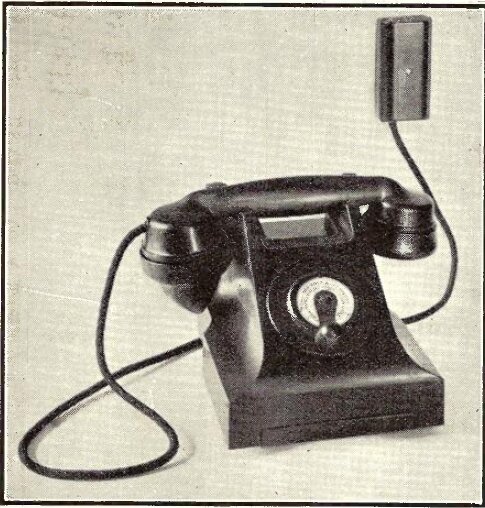
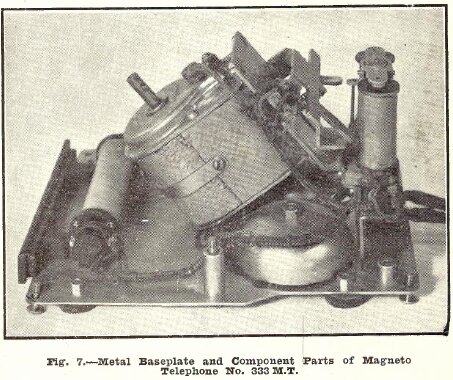
Magneto telephones were the earliest telephones
used with public exchanges. The exchange design is very simple, and the
only power source required is a battery (typically 3V) for the operator's
transmitter circuit. A hand generator (magneto) provides the ringing current,
typically around 100V AC.
Similarly, the subscriber's telephone
also contains a magneto and 3V battery.
In Australia, most manual exchanges in
rural areas were of the magneto type, since at the time of their implementation
there was generally no mains power supply, which is required for central
battery exchanges. Since magneto telephones were in use for about 100 years,
many different types were used, typically starting off with the Ericsson
'Skeleton', and progressing through various wooden and candlestick versions,
to the bakelite types described here.
This article concerns the 300 and 400
series phones issued in Australia by the PMG and Telecom.
The 300/400 series was a compact bakelite
table or wall instrument, of the same appearance as the automatic and CB
(Central Battery) versions. The only obvious difference is
the hand generator in the position normally occupied by the dial. One of
the advantages of the 300/400 series was that it eliminated the separate
magneto box, hitherto used with table instruments.
The 333 MT.
The first of the self contained table
instruments was the 333 MT (MT = Magneto Table) released
in 1938. This was an Ericsson design from England. The bakelite casing
is the same as the automatic and central battery 332 phones. The same 184
handset is used, as is the 20/4 terminal block. A drawer dummy is fitted
to the front of the case, since there is no room internally for a directory
drawer.
Internally, the design is quite unlike
the 332 auto/CB versions, with their separate chassis. All components of
the 333 MT are mounted on the baseplate, and the bell motor is mounted
vertically.


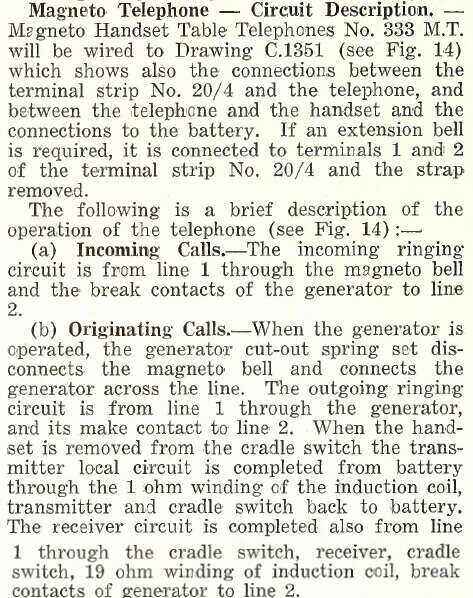
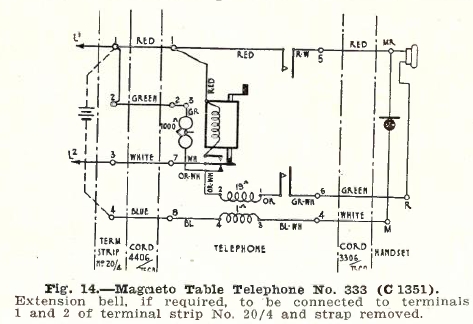
The 333 MT is a primitive instrument. It uses a plain induction coil with no side tone cancellation. There is no bell isolating capacitor. It appears that this instrument was not widely issued, with the improved 334 MT becoming available soon after.
The 334 MT.
The next of the self contained bakelite
instruments was the 334 MT, also of Ericsson design. It has a proper ASTIC
(Anti Side Tone Induction Coil), and
bell isolating capacitor.
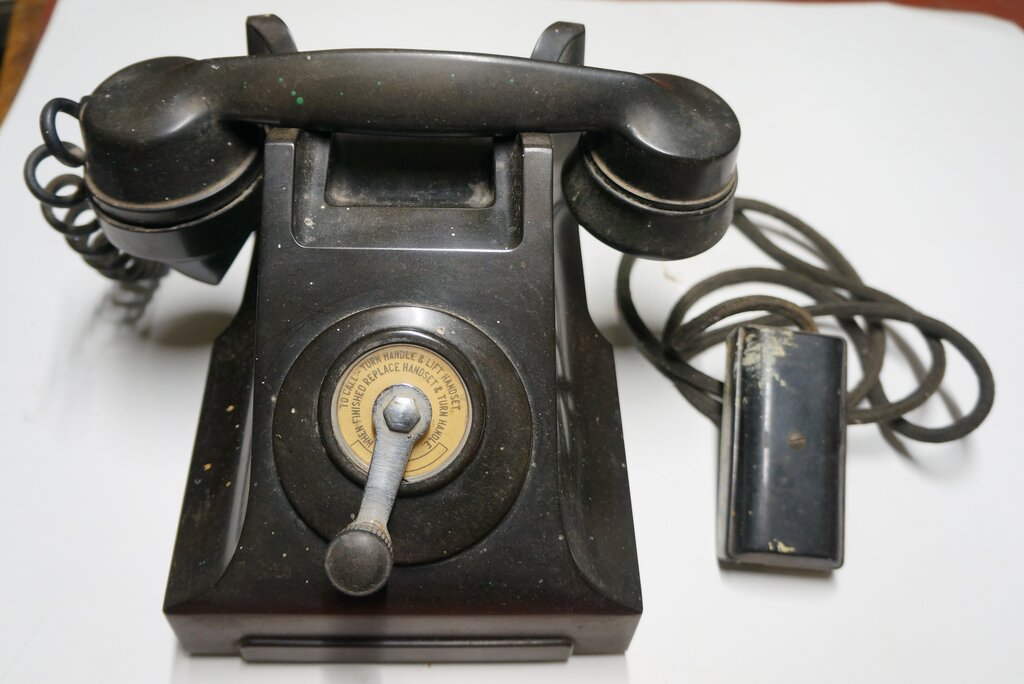
334 MT with 20/4 terminal block.
The 334 MT looks similar to the 333 MT, except the generator handle position is now offset. Since the 334 MT is fitted with a capacitor, the magneto had to be shifted slightly back.
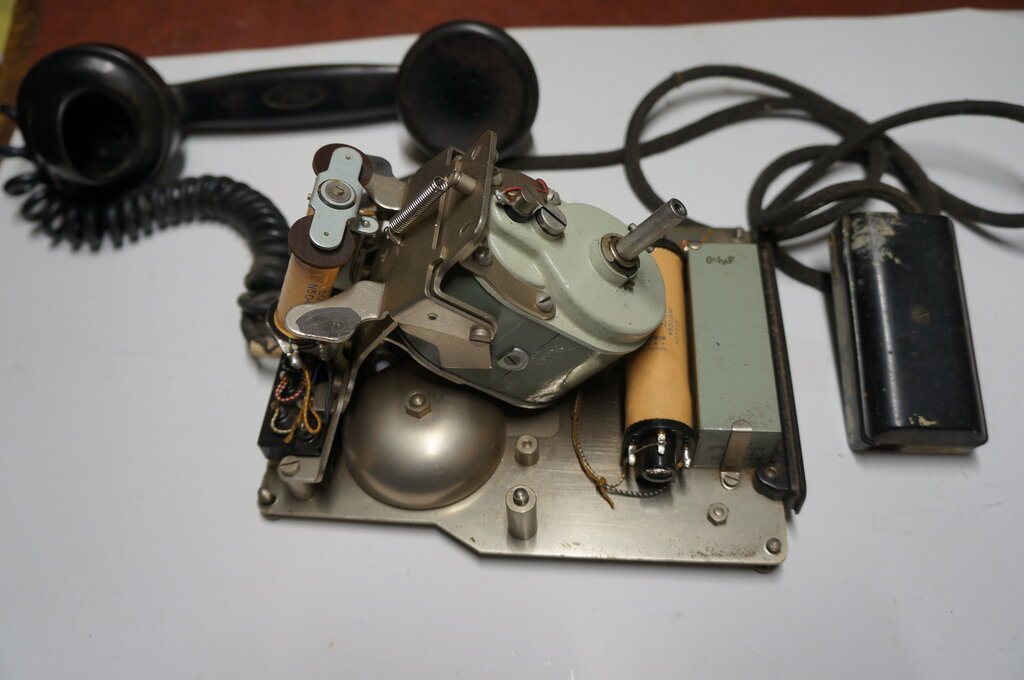
Note capacitor in front of the ASTIC.
The design does give the appearance of being cramped with everything only just fitting. The brackets to get the magneto to fit in just the right location, and at just the right angle, are quite intricate. As will be seen, the later APO 300 series was an improvement.
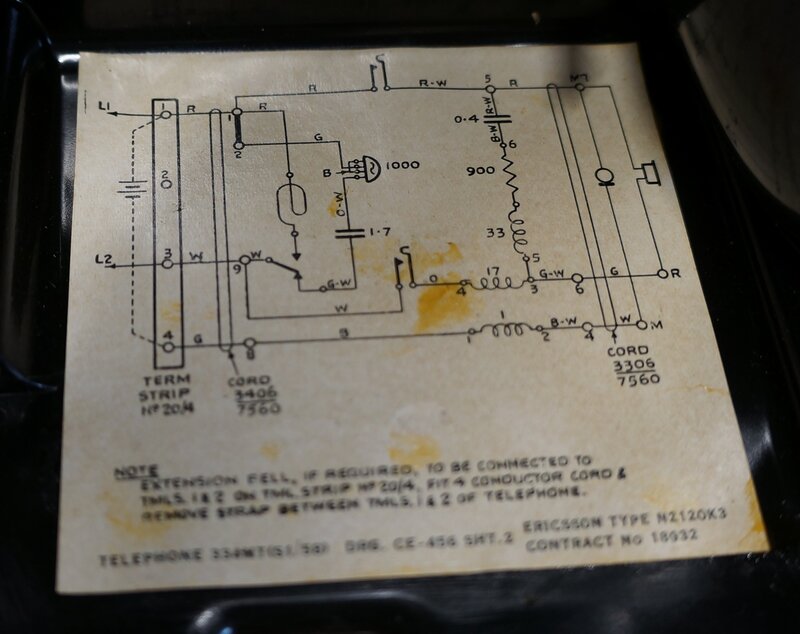
Circuit diagram of the 334 MT.
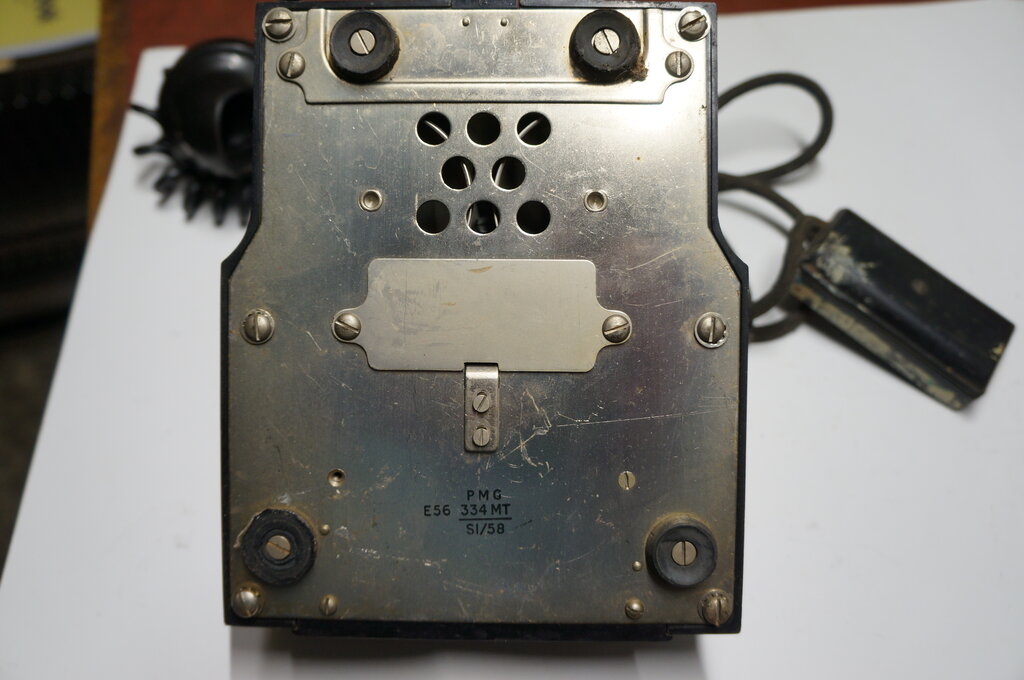
Plate in the middle provides access to the magneto. This phone was
made in 1956.
Because the chassis is so heavy, it's secured with six screws instead of four.
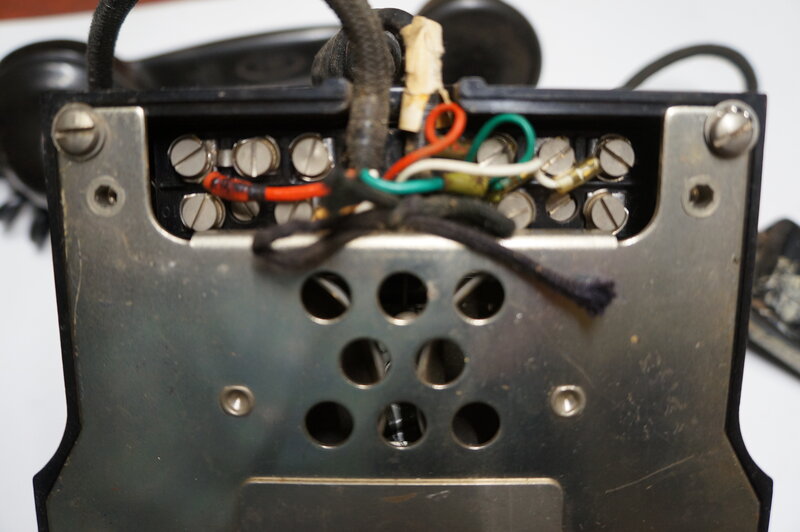
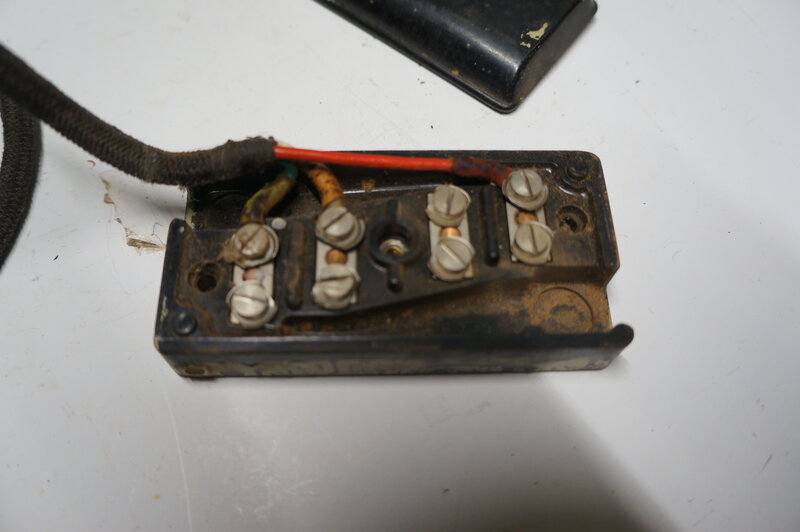
Connections in the phone and at the terminal block. Strain cord
is missing from the cord at the terminal block end.
300 MT.
The APO (Australian Post
Office)
released the improved series 300 design in 1945, with a more compact magneto
mounted in the case, and a tidier chassis layout based on the new automatic
and CB versions. Directory drawers were not provided for, so the drawer
dummy is absent. The new magneto design was available as the 300 MT (table),
300 MP (portable) or 300 MW (wall). The smaller magneto allowed the use
of the new wall casing, which would not be possible with the Ericsson magneto.
The APO telephone weighs noticeably less than its Ericsson counterpart.
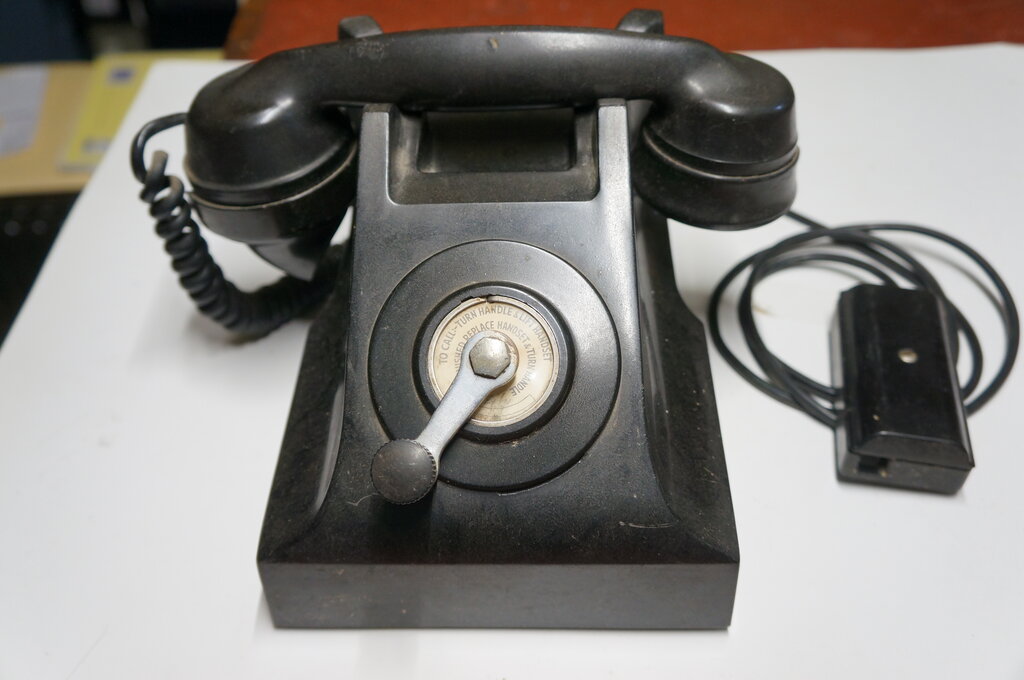
Note the magneto handle is centered in the escutcheon. This phone
is connected with a 20/4 terminal block.
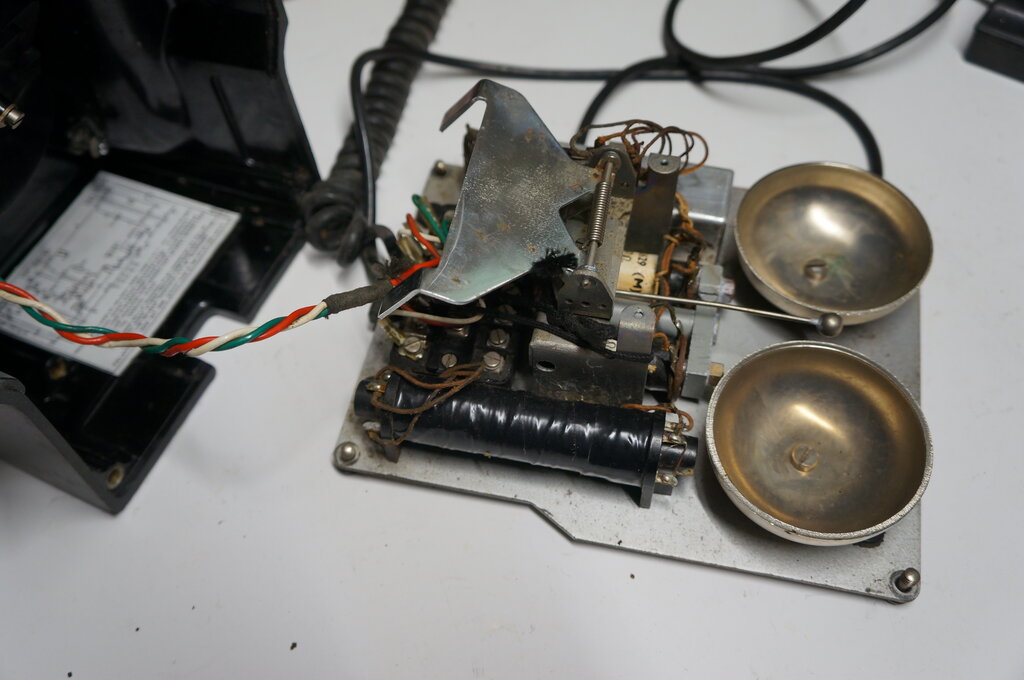
Internally, the same construction and layout is used as per the
APO series 300 automatic and CB instruments.
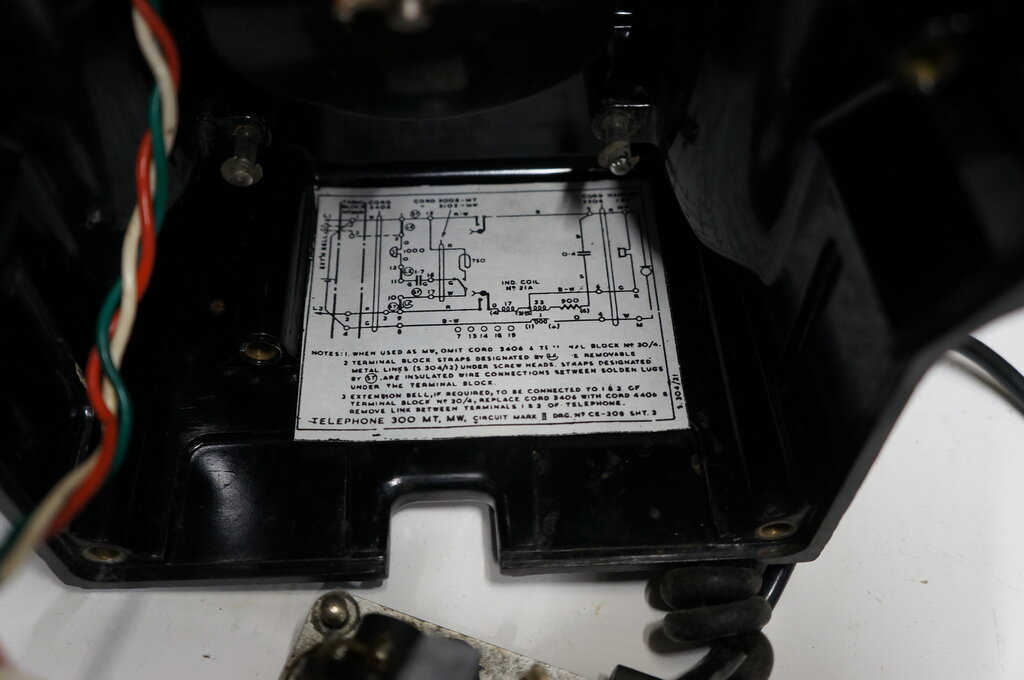
Circuit of the 300 MT.
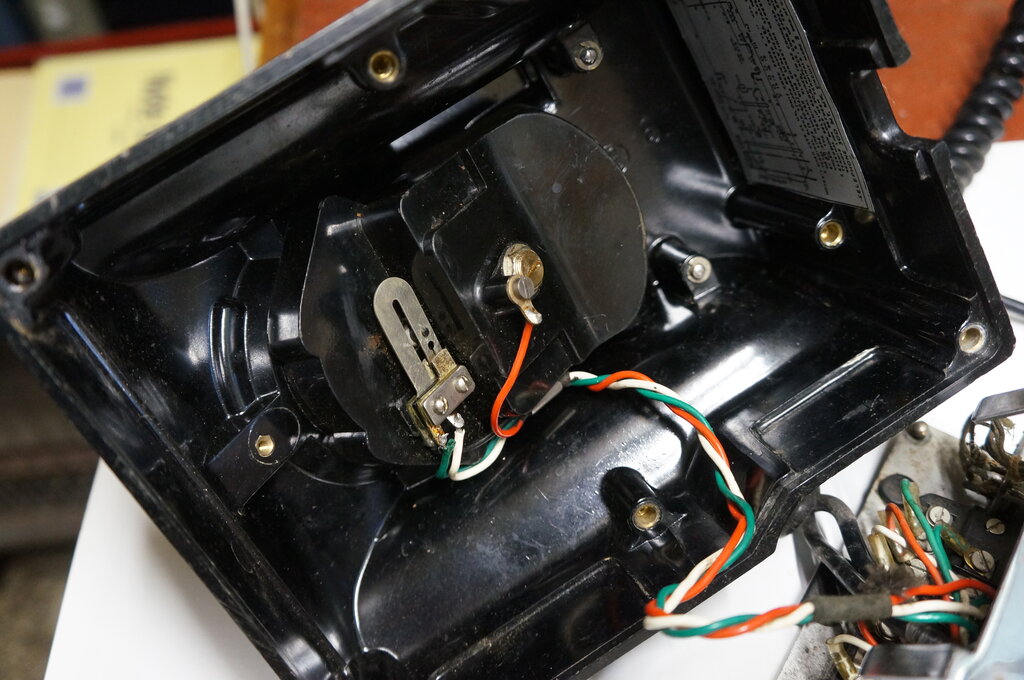
APO magneto mounts on the casing where dial would go in automatic
models.
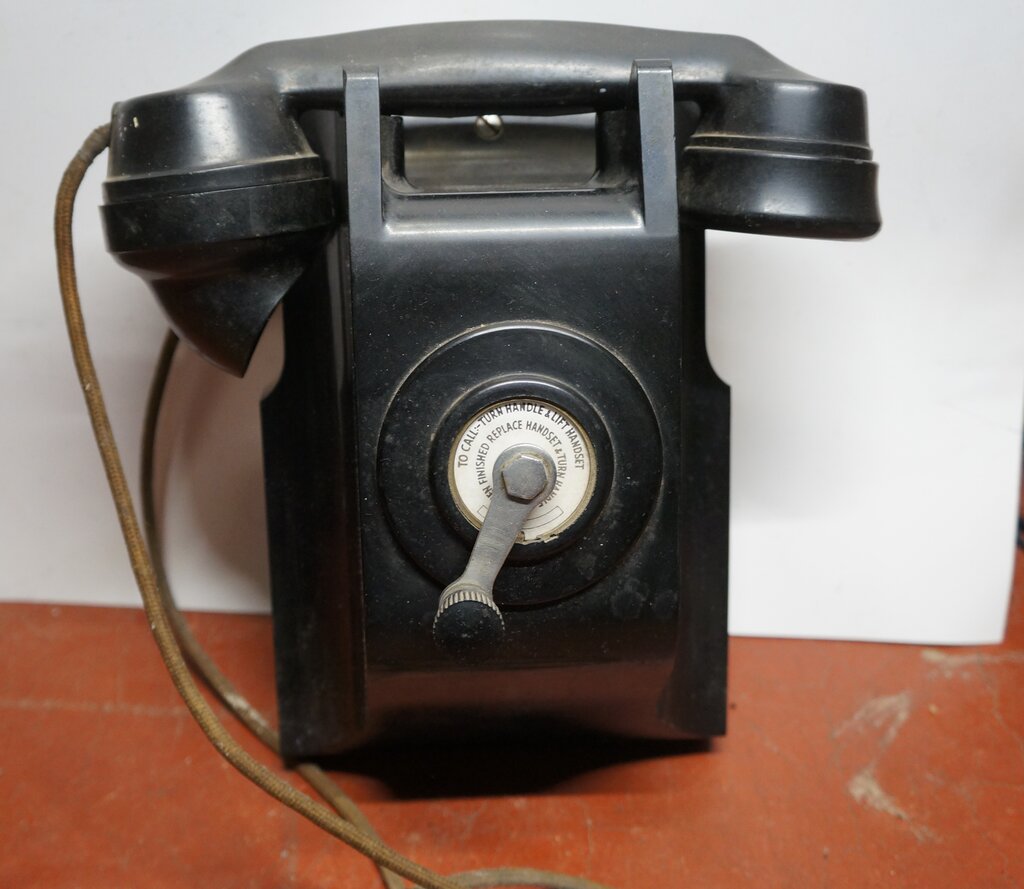
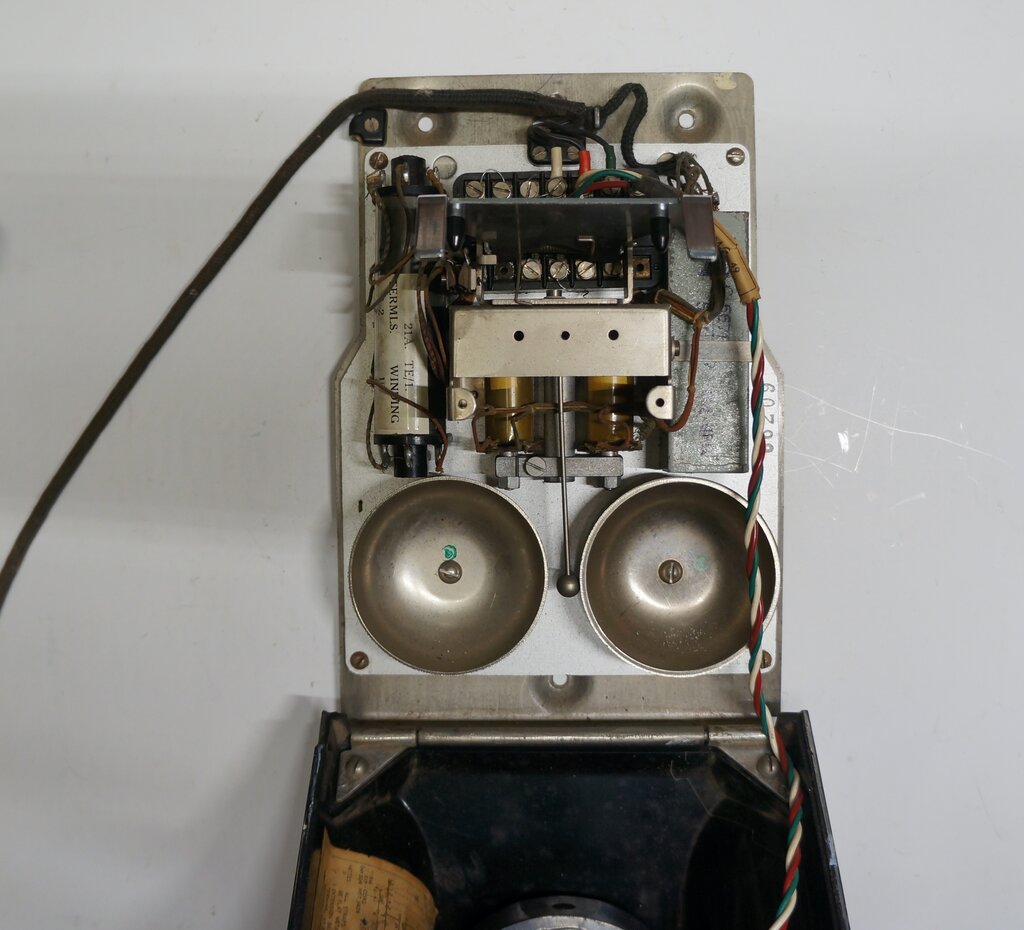
Table model chassis attached to backing plate for screwing to the
wall. Casing remains attached by a hinge when opened.
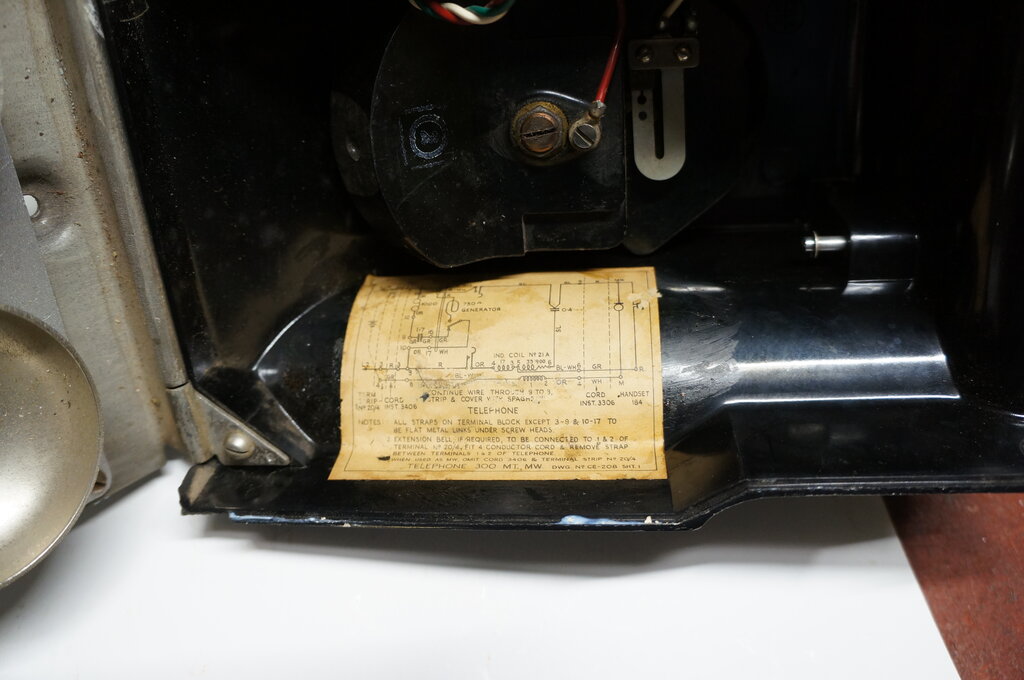
Circuit of the 300 MW.
300 MWK.
This 300 MWK (Magneto Wall Key) version
has a key switch to prevent unauthorised outgoing calls.
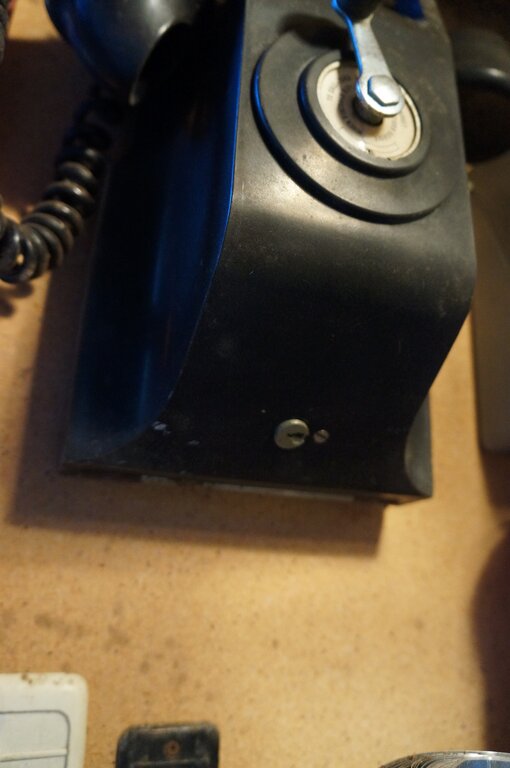
Key switch visible under the front of the phone.
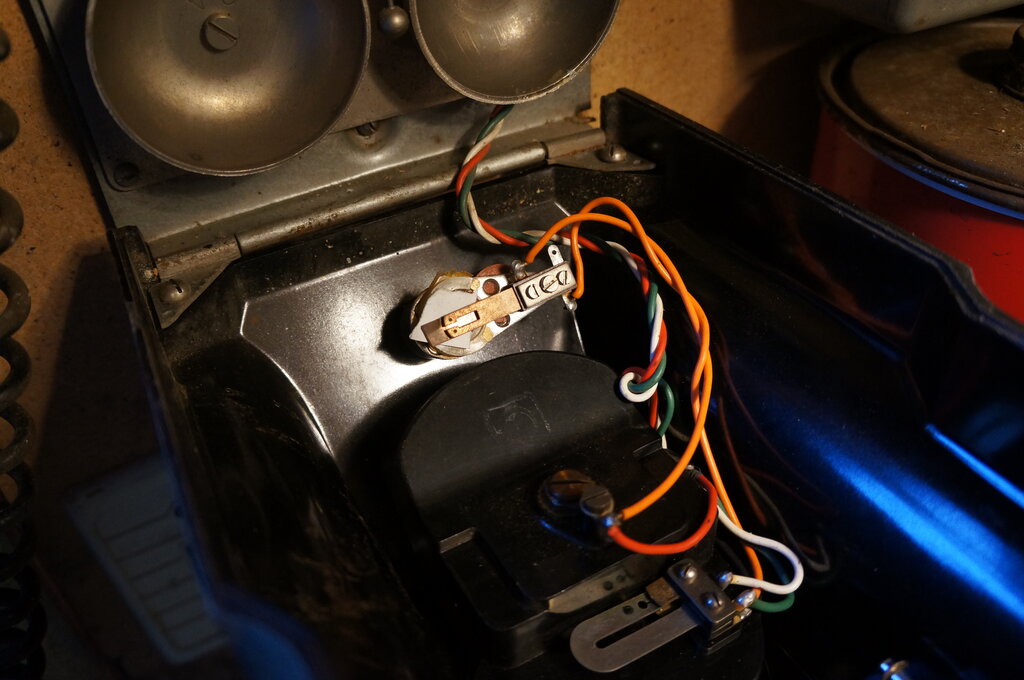
Astute readers might notice the paper between the contacts. The
key switch is "on" and I hadn't got around to picking the lock.
The key switch simply shorts out the magneto so that the exchange cannot be called. The ethics of key switches on telephones is questionable in case of emergency.
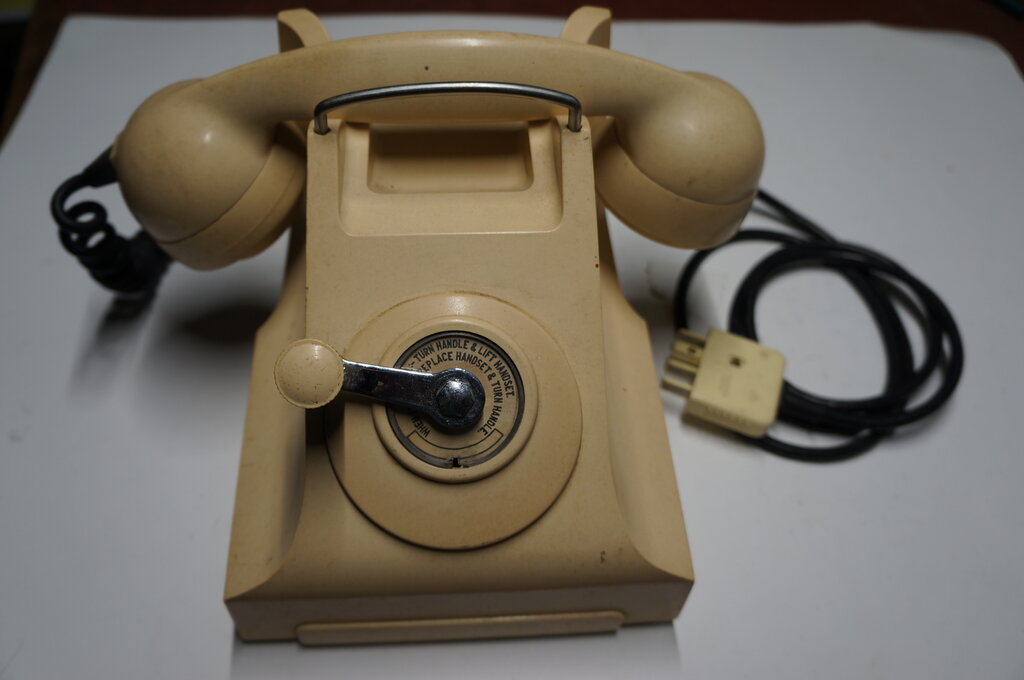
This ivory 400 MP is fitted with a handle for portable use. Note
the 603 plug.
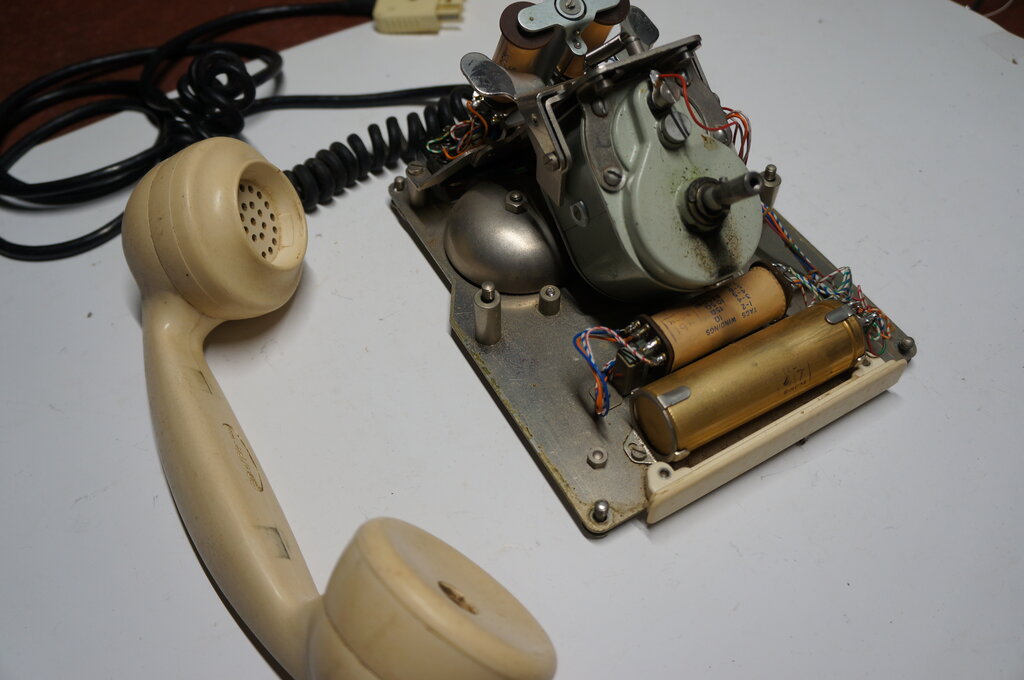
Internal layout is the same as the 334 MT.
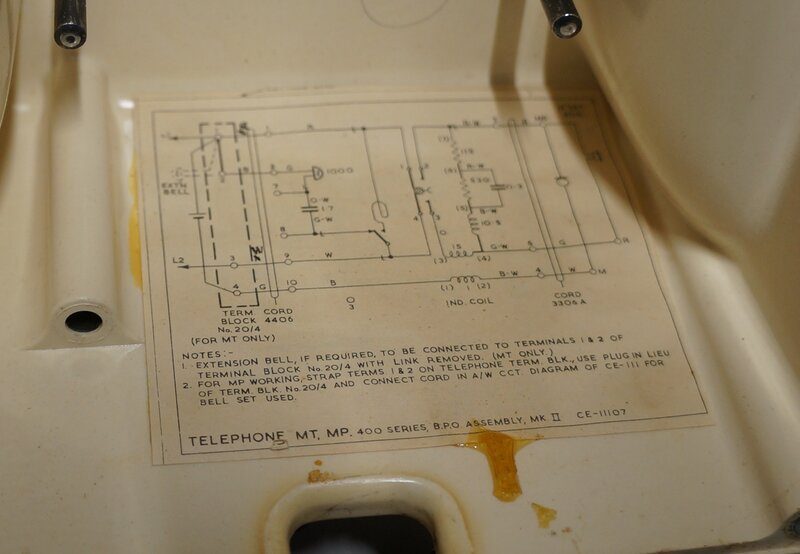
Circuit of the 400 MP. Terminal block is shown instead of the plug.
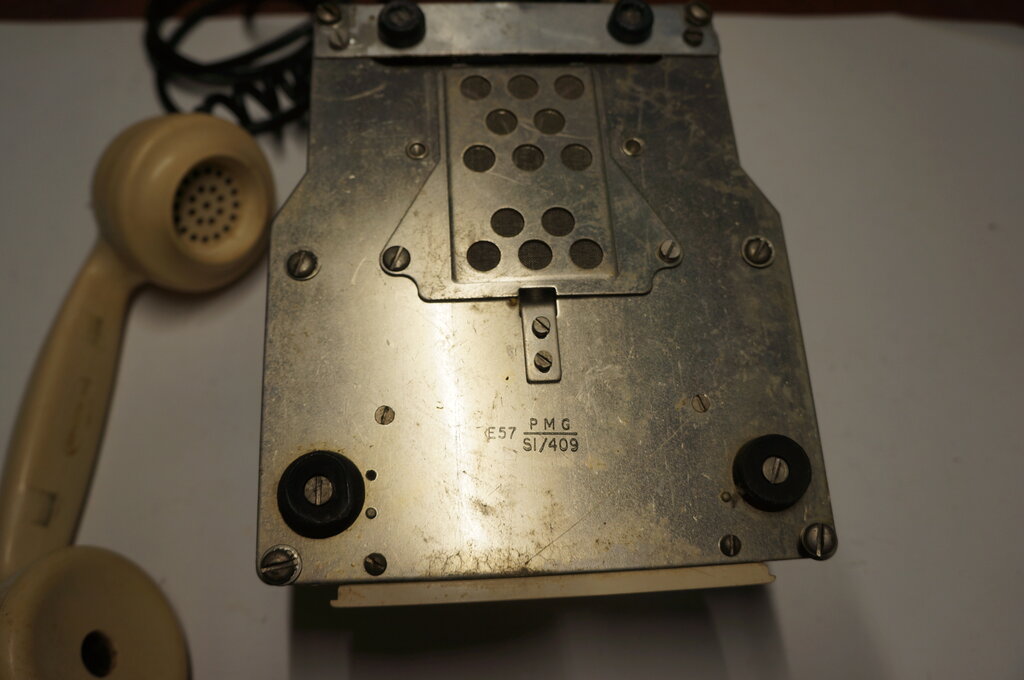
Under the chassis of the 400 MP. Made in 1957. S1/409 designates
Ericsson (BPO) portable 400 series magneto with ivory case.
400 MT.
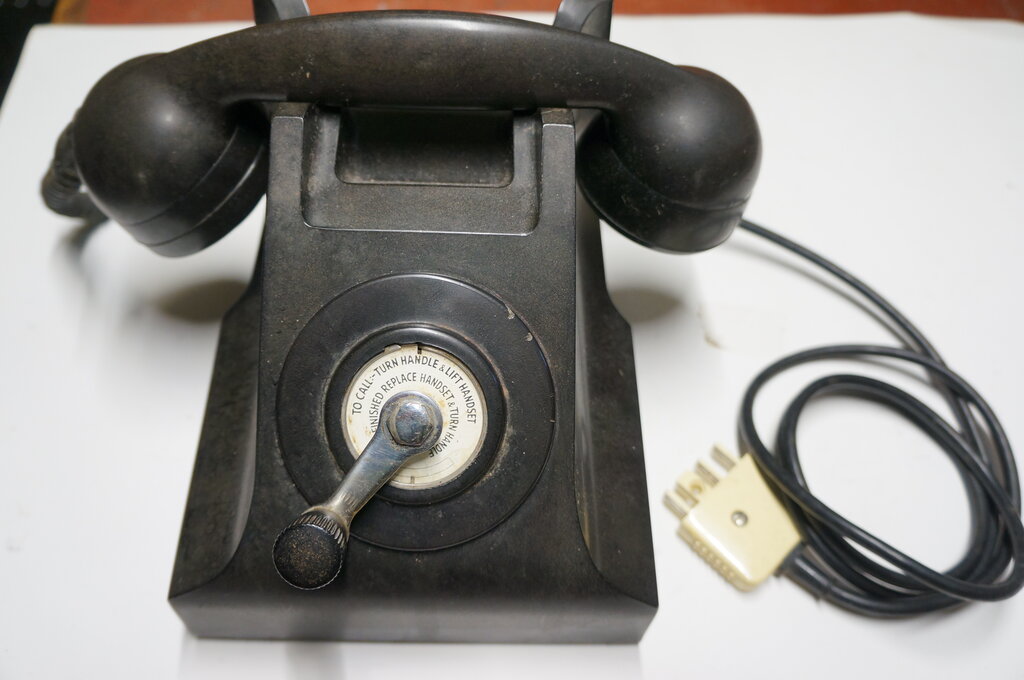
Note the centrally positioned magneto handle. This uses the APO
magneto.
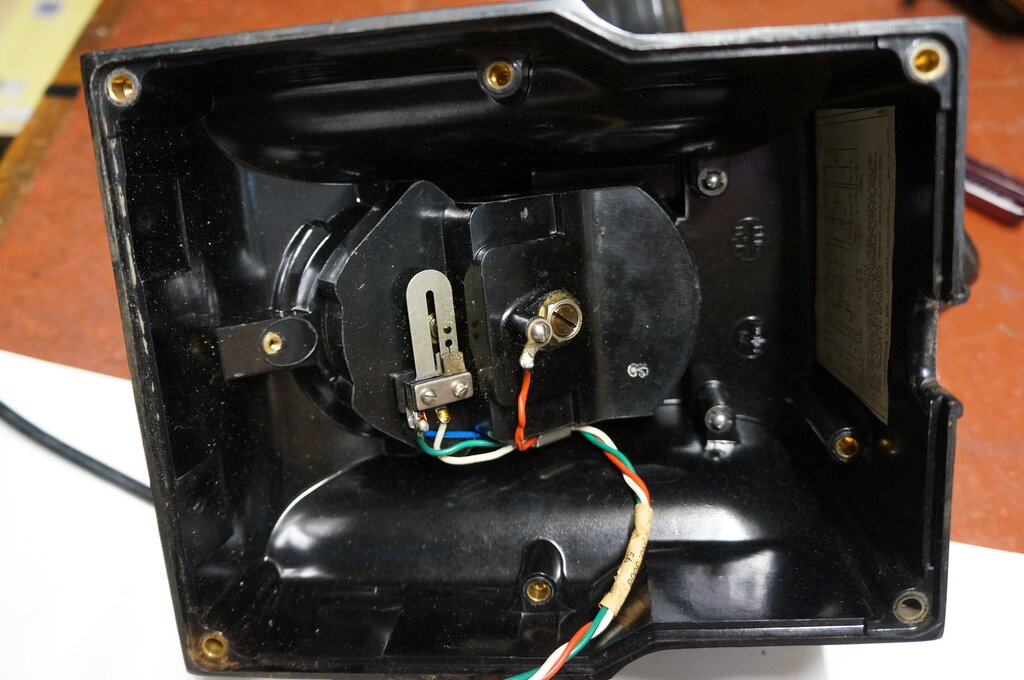
APO magneto mounts in the case.
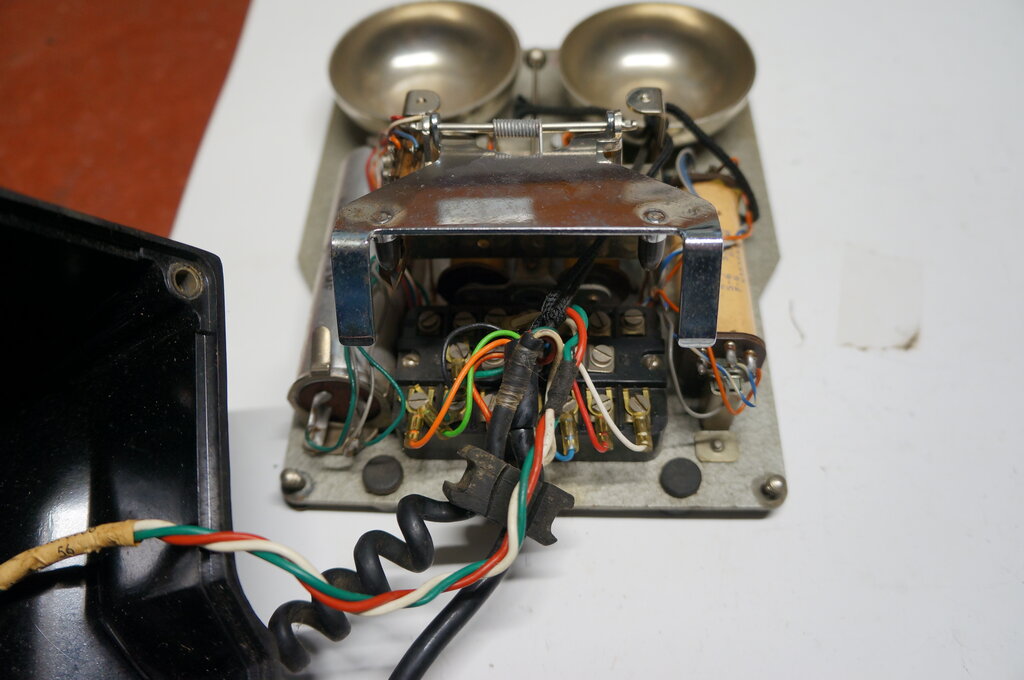
Terminals in the APO 400 MT.
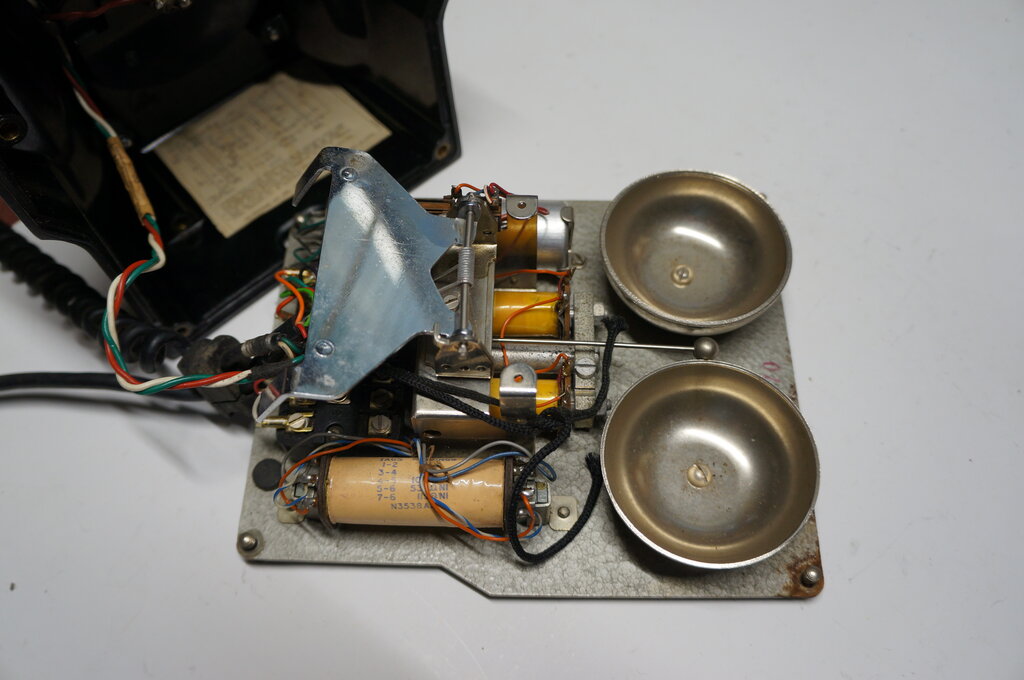
Layout is just like the APO automatic and CB instruments.
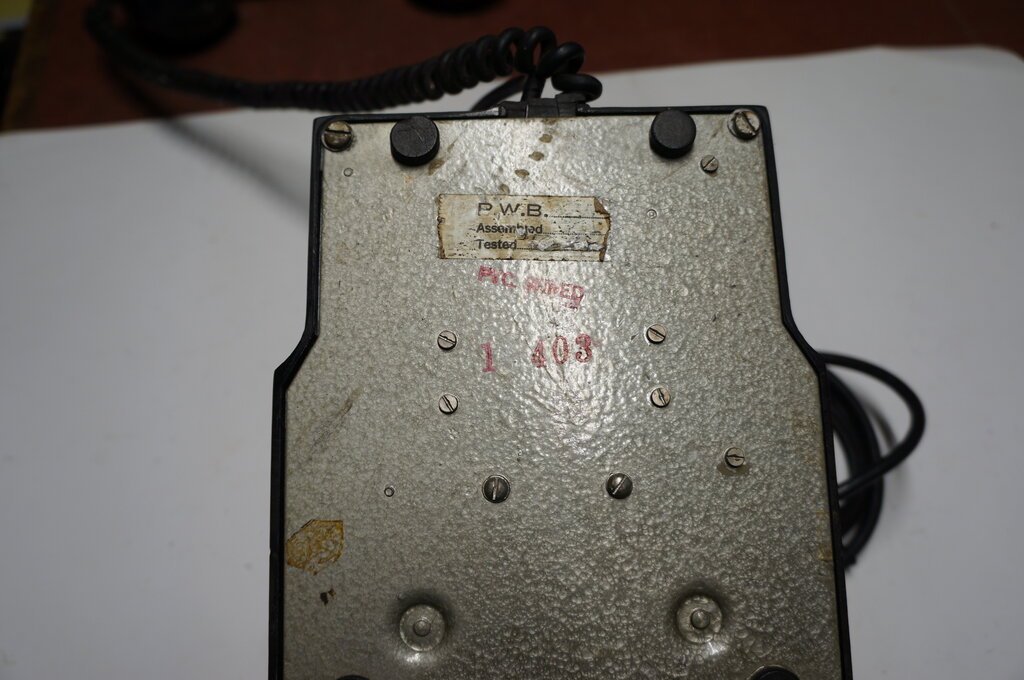
S1/403 designates a black APO series 400 magneto table telephone.
This one has been reconditioned, apparently in 1979, as indicated by the
date stamp on the plug grommet.
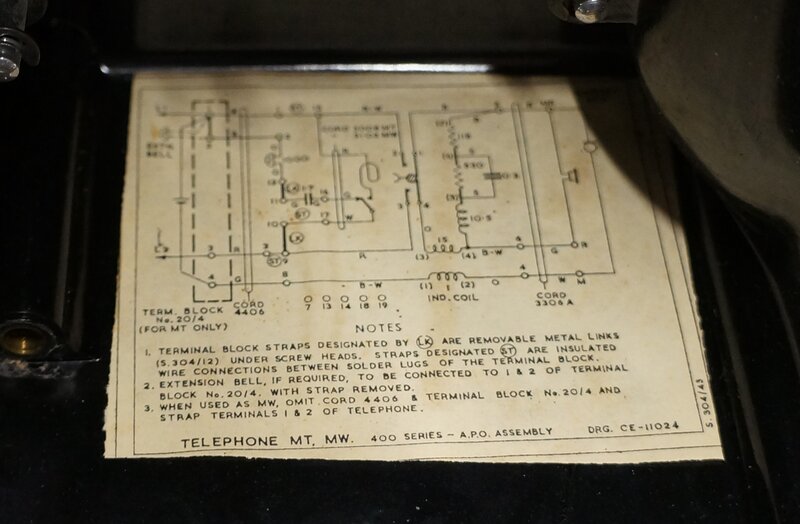
Circuit of the APO 400 MT. Originally fitted with a terminal block,
the 603 plug would have been fitted at the time of reconditioning.
400 MW.
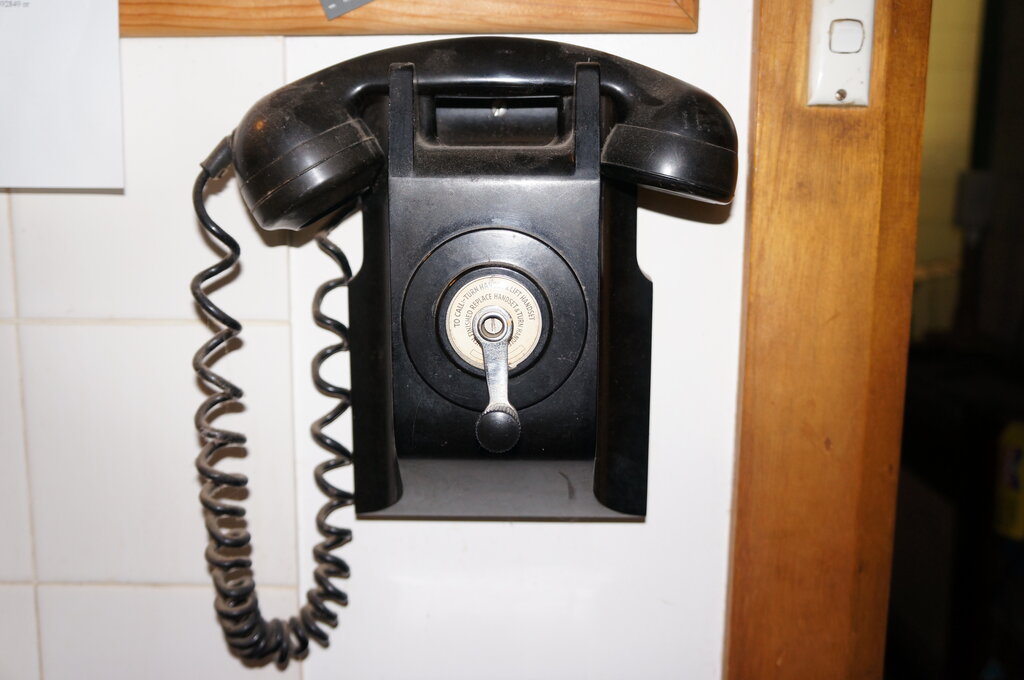
The casing for the APO wall models is unique to Australia.
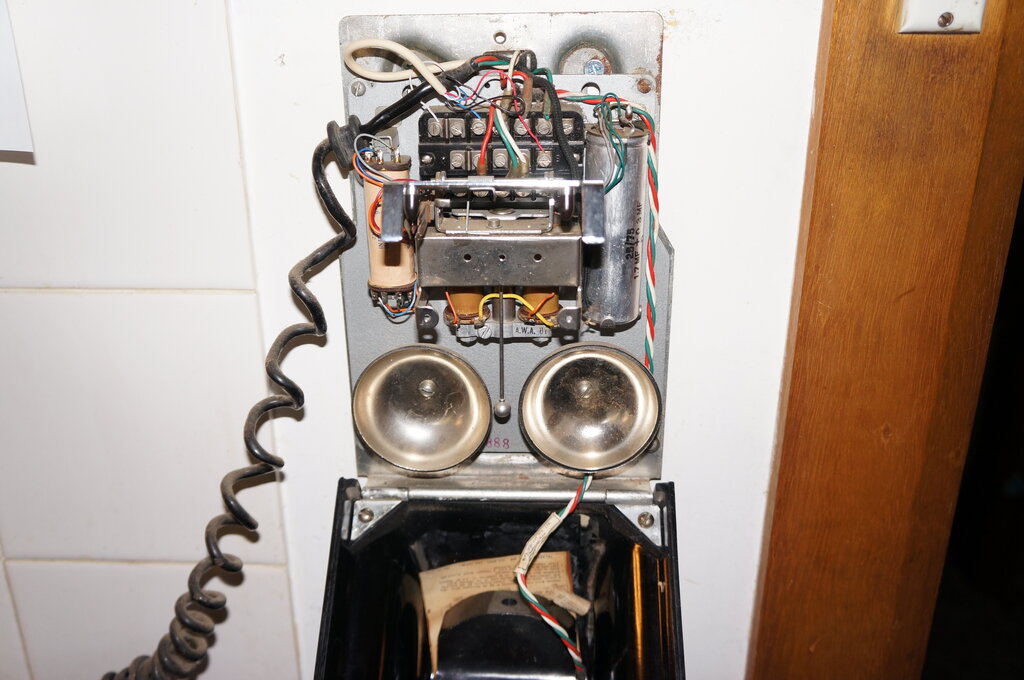
The same chassis is used as with the table model, but the gravity
switch is mounted differently. Line connections are made directly to the
terminal strip.
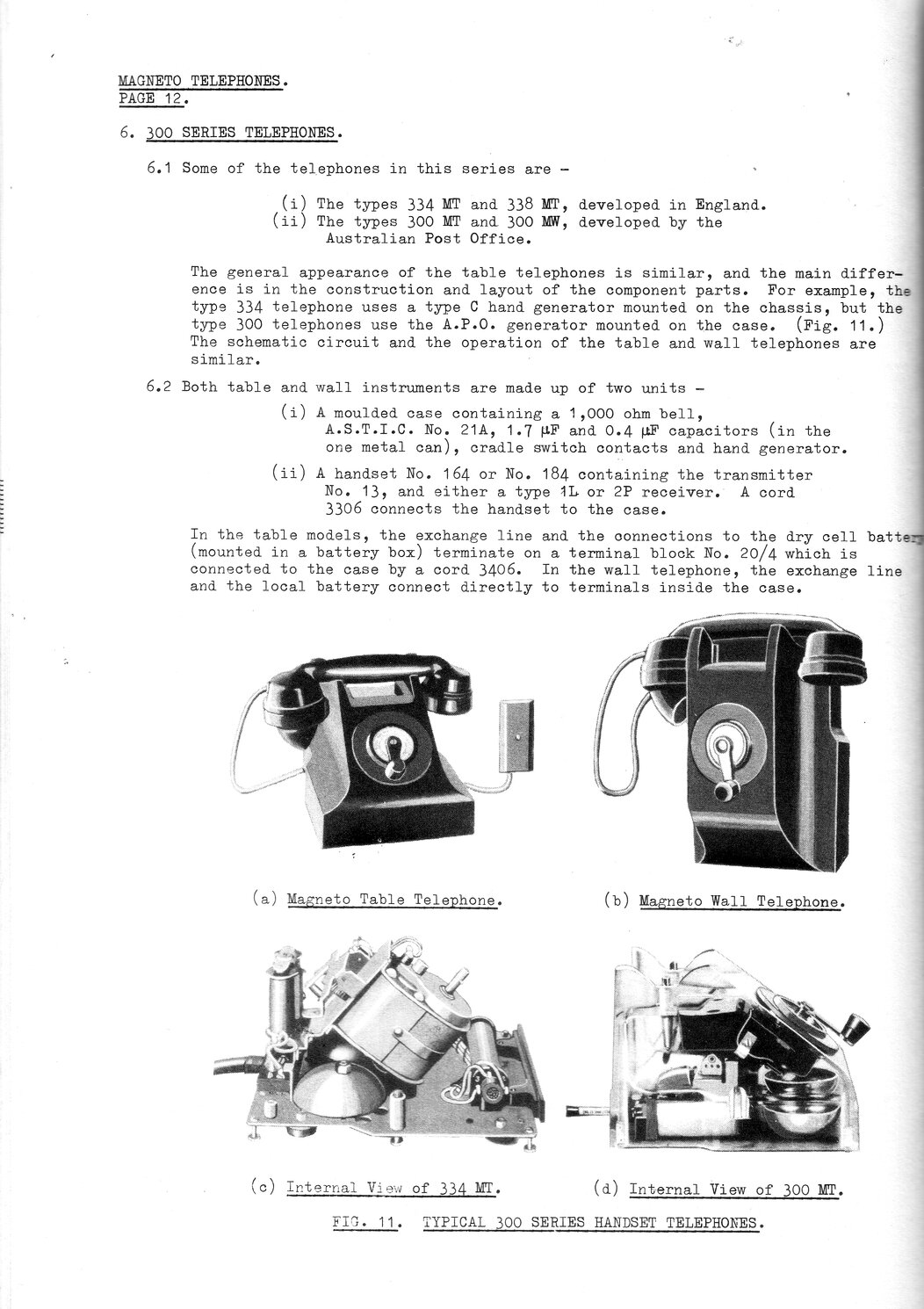
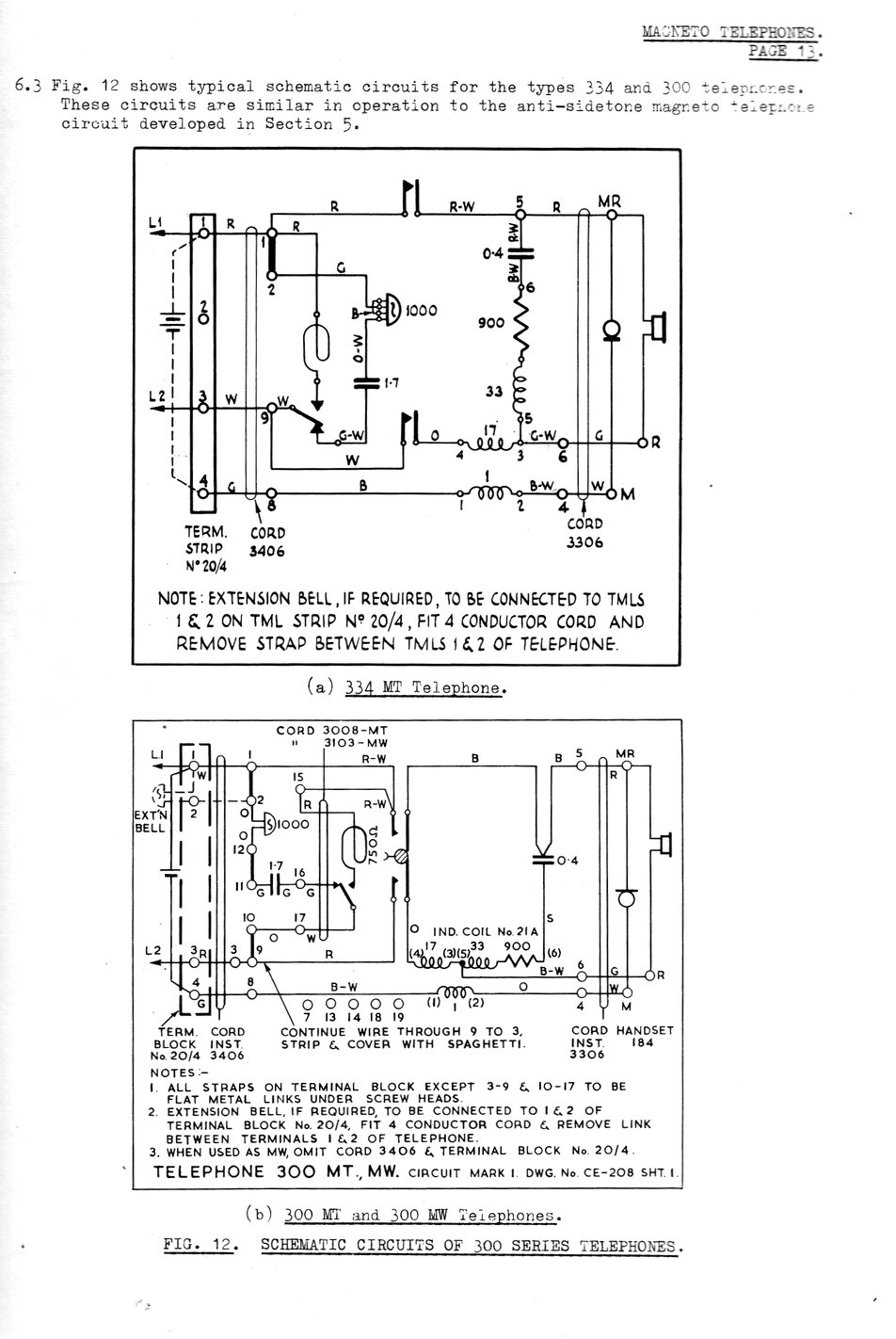
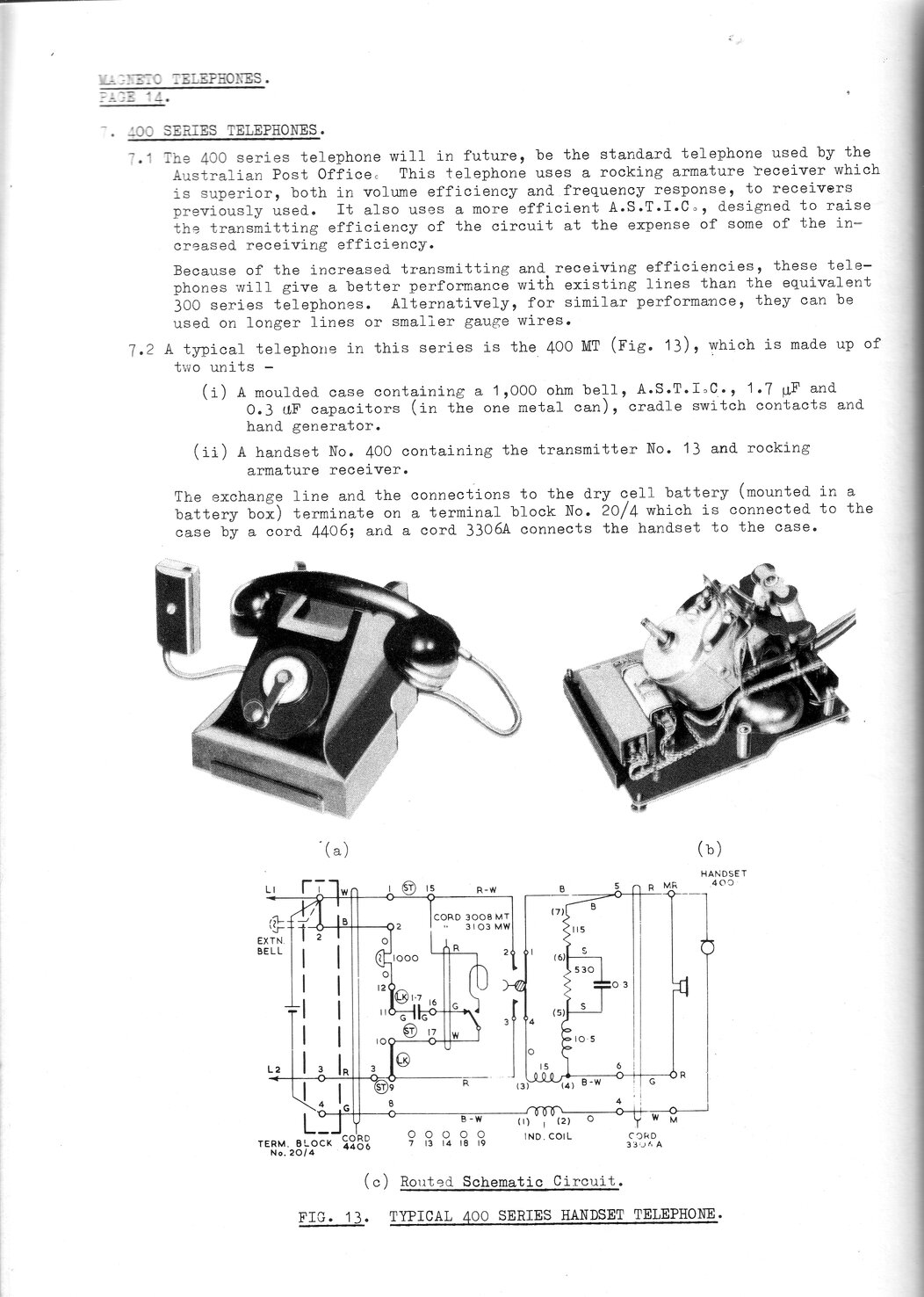
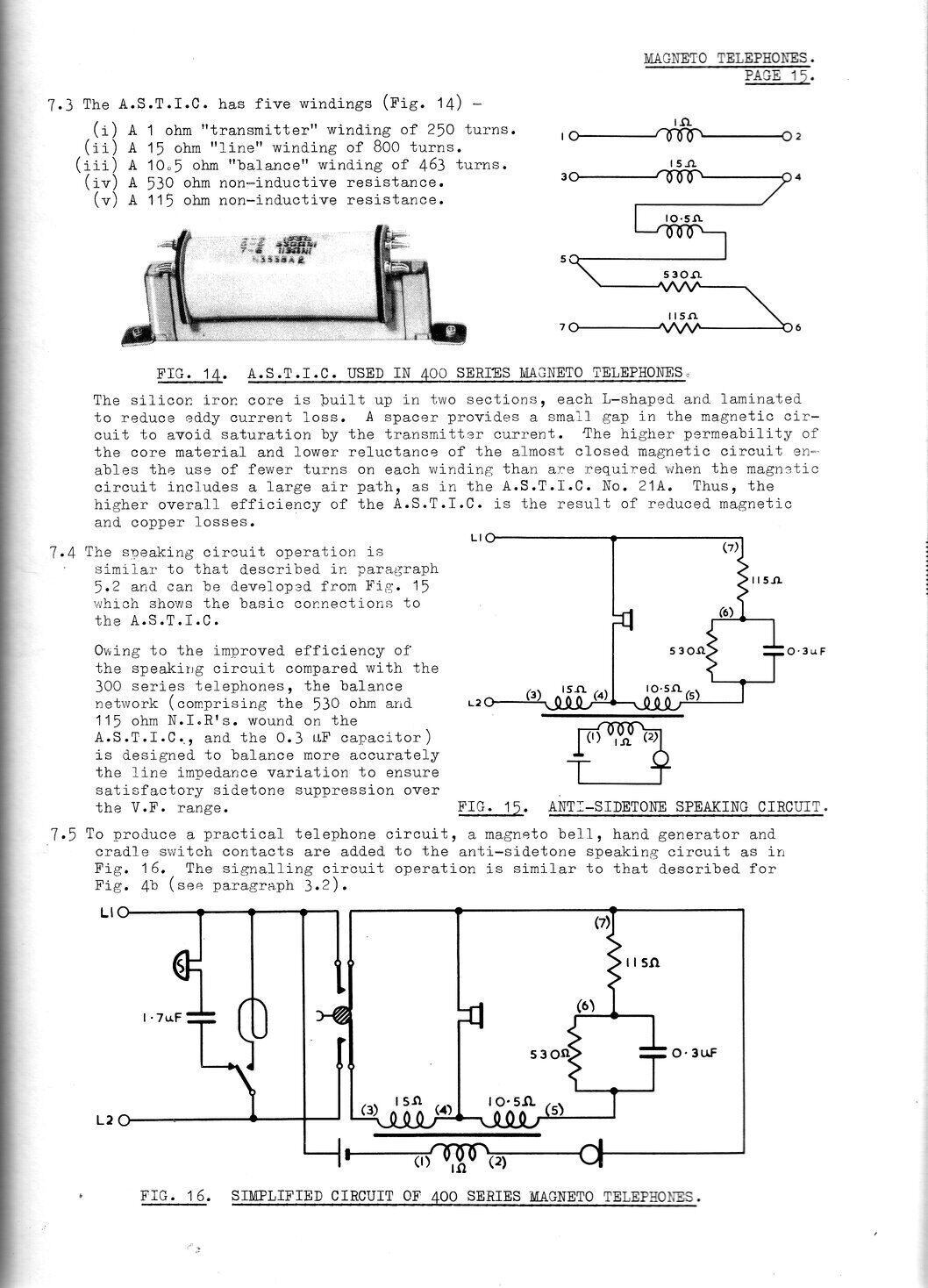
This description appears to have been compiled prior to the development of the APO version of the 400, since it is not mentioned.
The Magneto.
As previously seen, two types of magneto
were used; the Ericsson type C for the BPO table telephones, and a locally
designed more compact type used for the APO table and wall telephones.
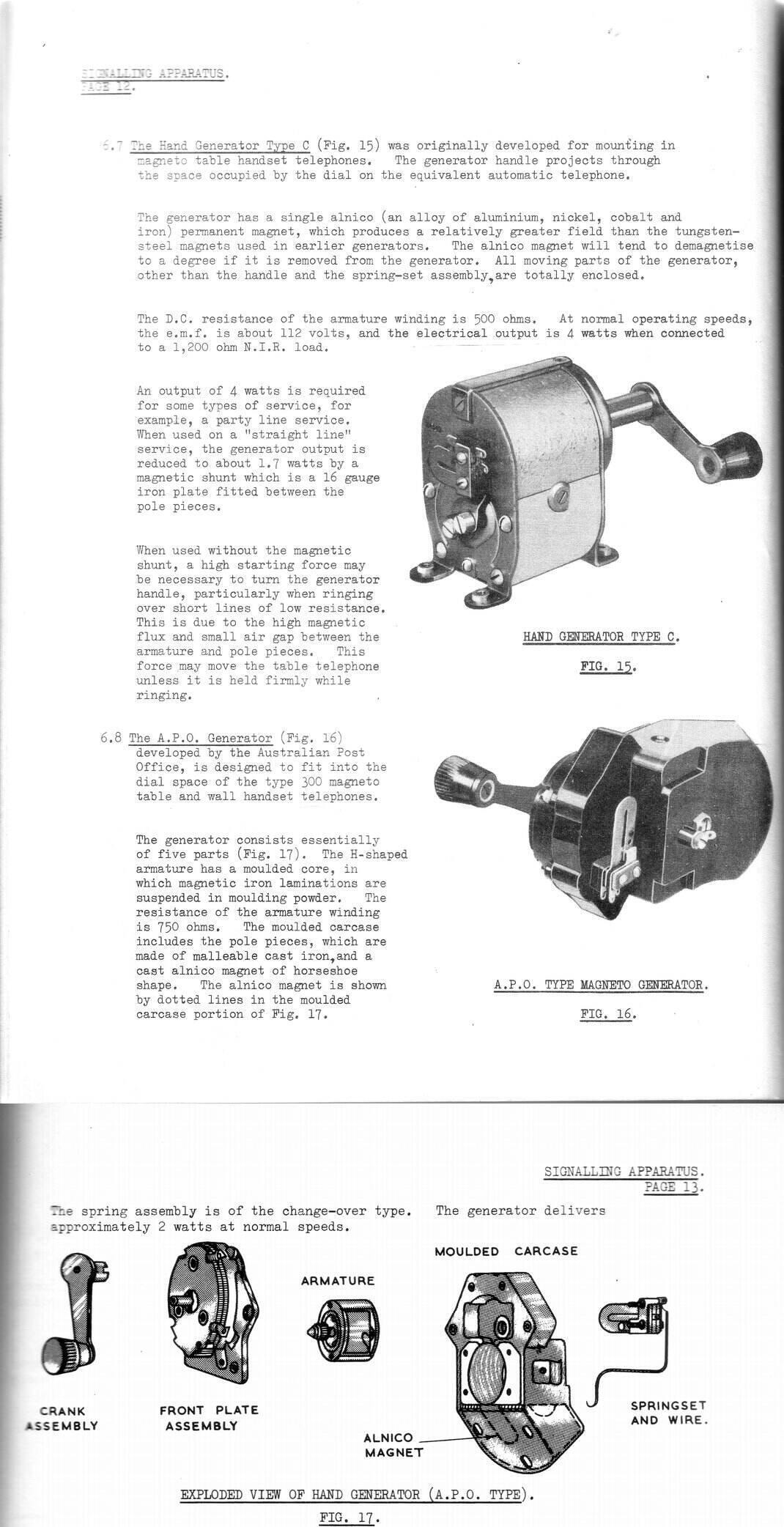
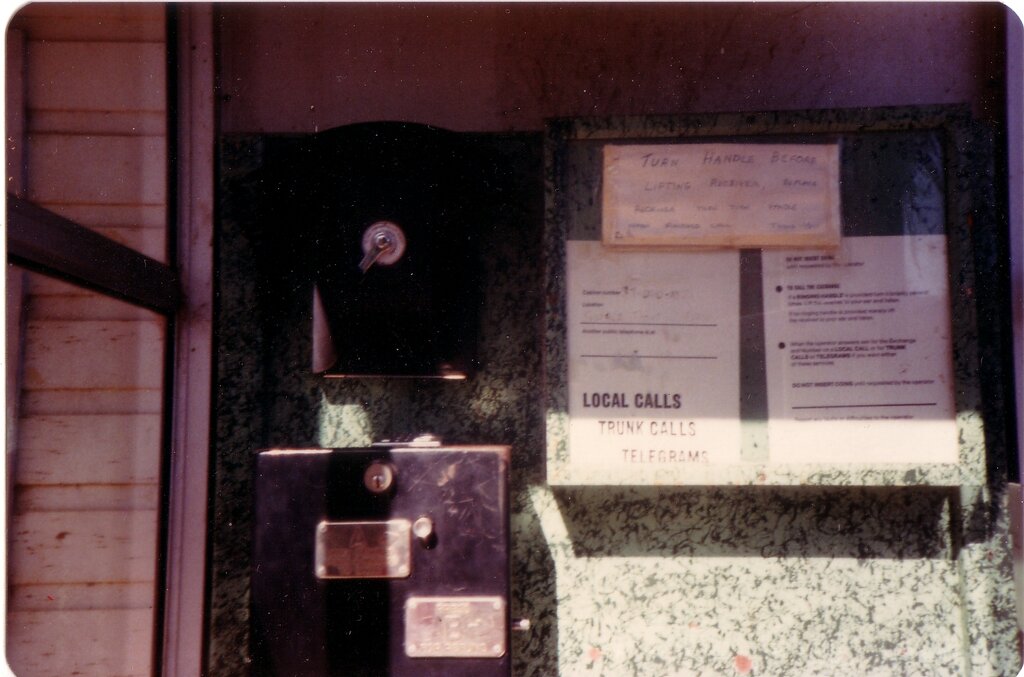
Public phone at Sofala, May 1983.
Sure enough, once at Sofala it didn't take
long to spot the one and only phone box - complete with magneto wall phone
and AB coin box. It was outside the post office. So, we went in thinking
maybe the exchange operator could tell me where I could find a magneto
phone.
And here my luck came good, because there
happened to be a technician there. He said that yes he might be able to
help, and then called a colleague at the Bathurst exchange to ask if they
had any. Indeed they did, and if we went back to Bathurst I could pick
one up.
I can't remember the exact details now,
but I remember being outside the exchange and the technician's colleague
asked if I wanted a wall or desk phone. I said desk phone. Moments later,
a box was thrust into my hands. Seeing if I could push my luck just a little
further, I asked if I could have "a pair of No. 6's to go with it". And
sure enough, out they came too. What astonished me more than anything was
this was all "new in box". And it was given to me free. I was expecting
to get a well used phone with paint and chips, which I would have been
delighted with, but this was new store issue!
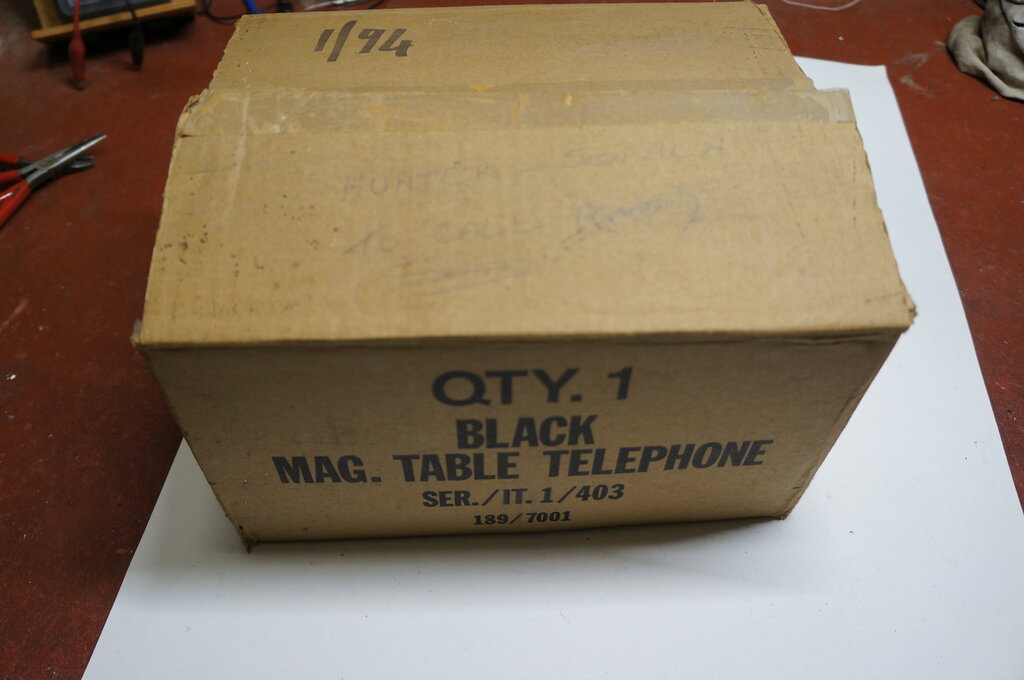
A close look will make out, "Hunter - Sofala. To call (Goodie)"
Ian Goodwin was the technician working at Sofala that day.
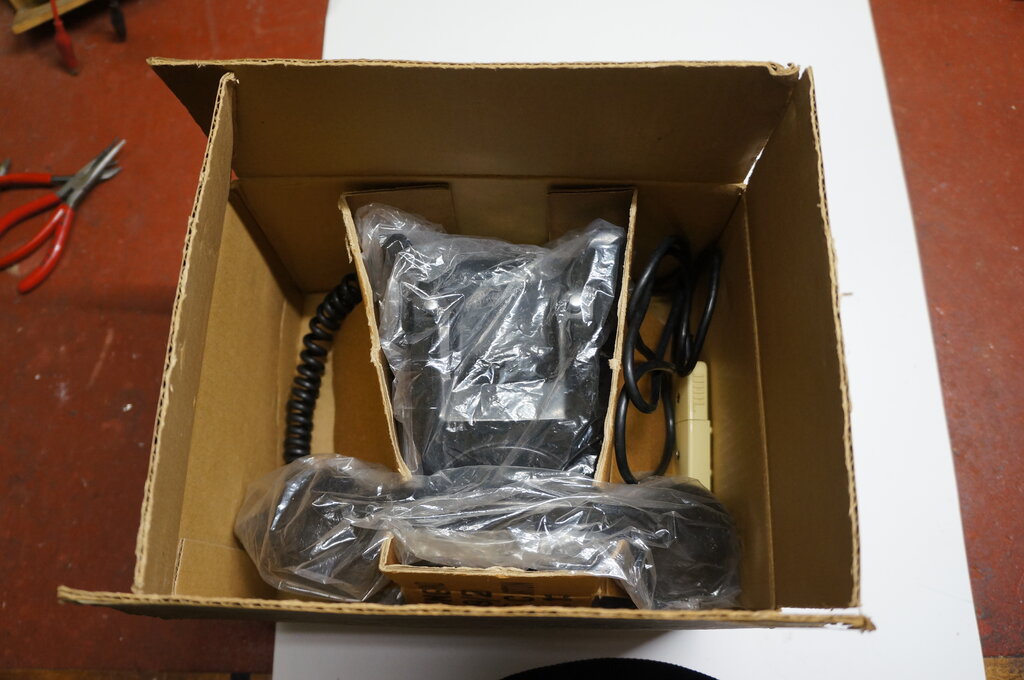
It really was better than I could have imagined. All shiny and clean,
wrapped in plastic.
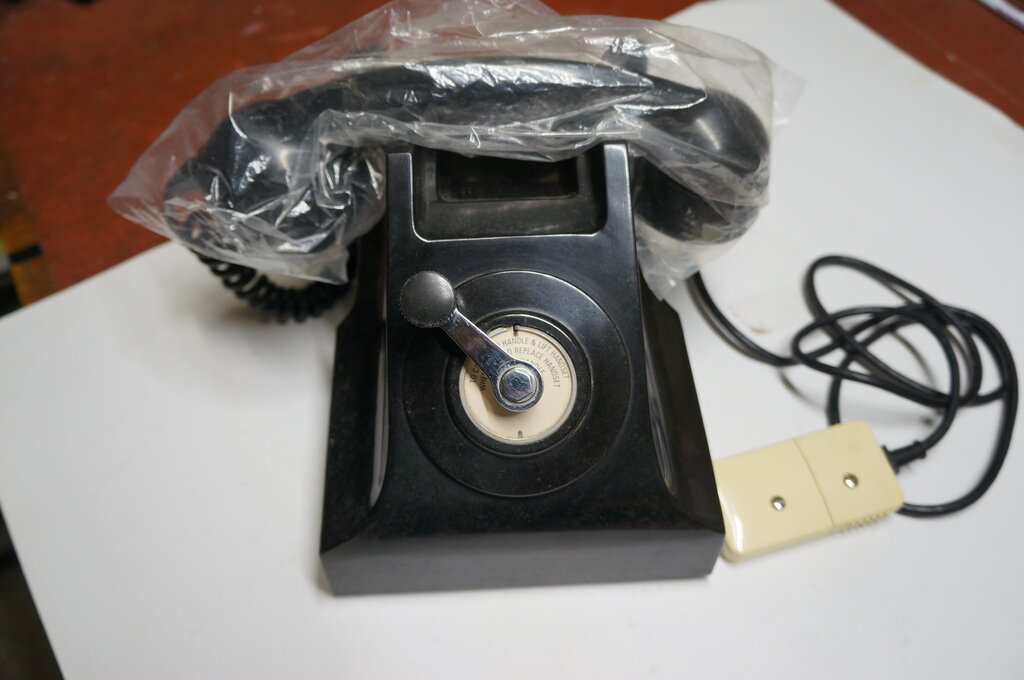
It even came with a 610 socket.
It turned out it was a reconditioned phone; fully rebuilt. 39 years later in 2022 it has faded a little, and could do with another polish. I had already known that magneto phones were reconditioned in the Hobart workshops, and this was such an example. This is where magneto phones went, once removed from service.
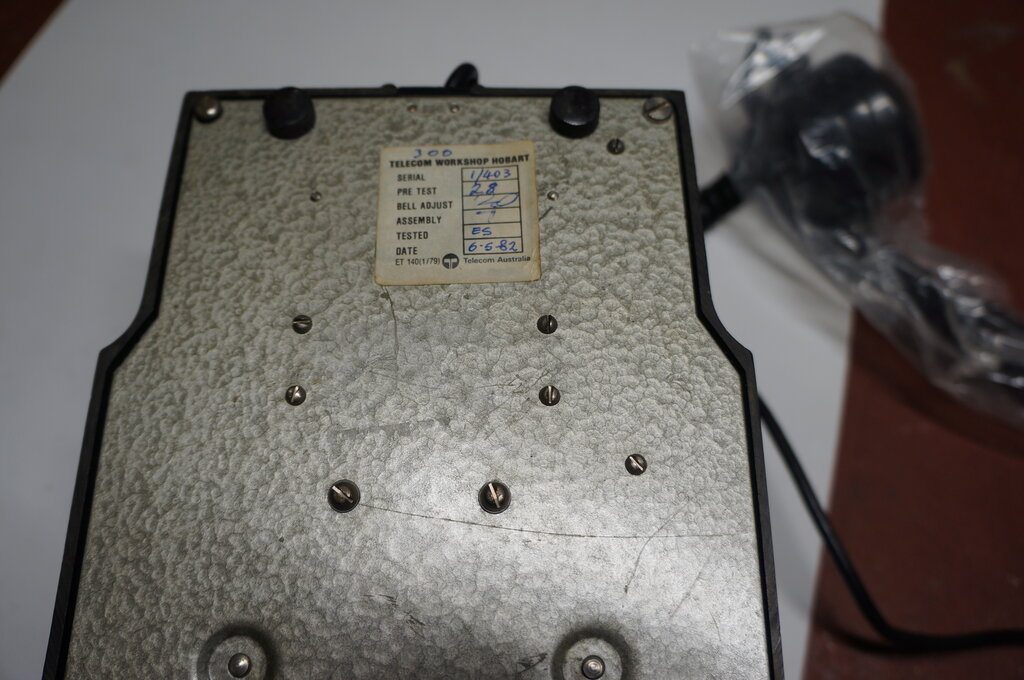
Although the serial is 1/403 which suggests a series 400, the phone
is actually a series 300. Note the "300" at the top of the label.
Inside the phone it looked like it had been completely rebuilt with new plastic wire and modern capacitors. The date shows it was reconditioned exactly a year before I got it.
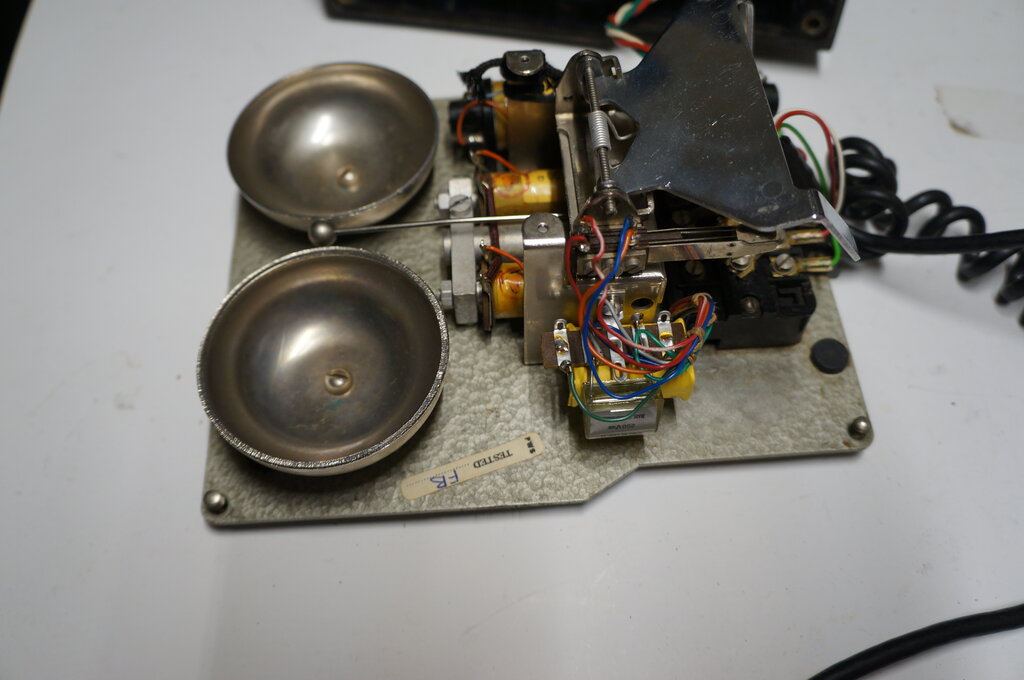
New wiring and capacitors.
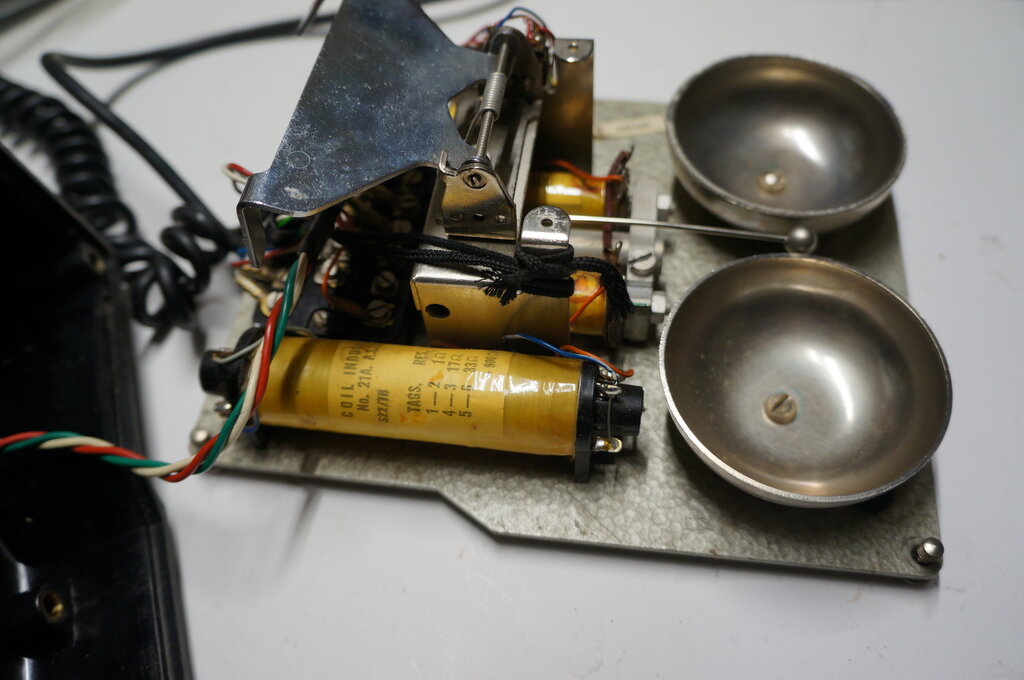
The induction coil shows it's a series 300.
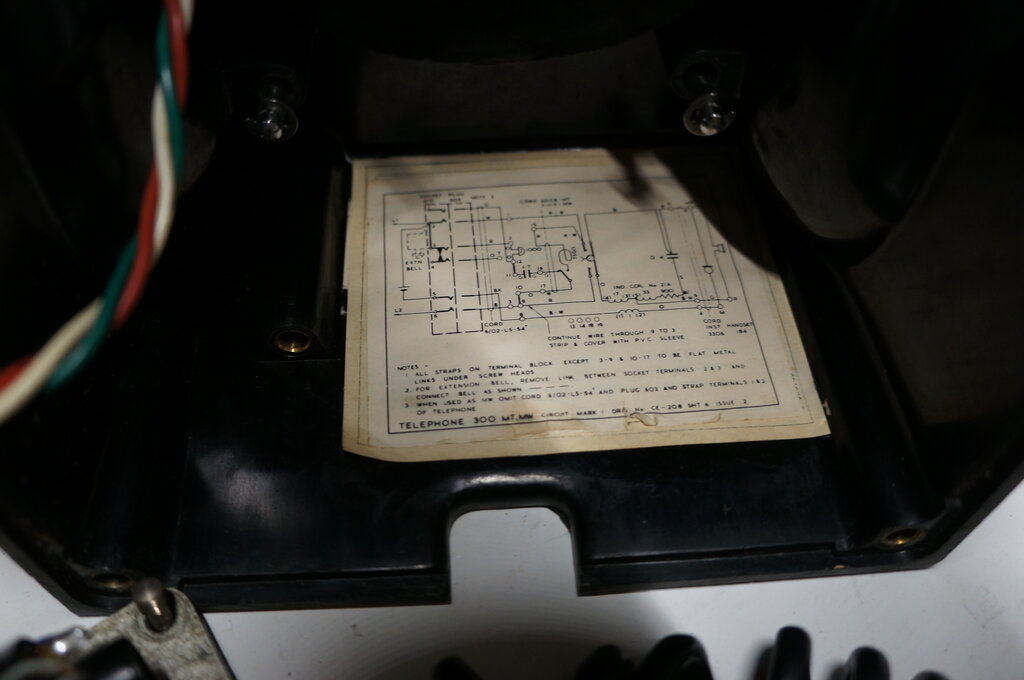
Circuit shows 603 plug & 610 socket. I don't know what the original
label is for - the new one is stuck too well so can't lift it up.
An interesting thing is that although it is labelled as a series 400, it's actually a series 300. So far, this is the only reconditioned series 300 I've seen; all have been 400's. It would appear that series 300 was no longer compatible with Telecom's paperwork, so it was designated 400. The fact that a magneto phone is fitted with a series 400 handset should not make one automatically assume the phone is a 400, as is the situation here. Only by opening it up and looking inside can it really be identified. The most obvious difference is the ASTIC's.
This phone was put into service as an intercom
for a couple of years at my then place of residence. The other phone connected
to it was a field telephone.
Needless to say, once I got this phone,
others started to appear later in the 1990's. In fact, they seemed to become
quite prolific as time went on - possibly because there are no longer any
manual exchanges. On that note, I recently did get a six line pyramid exchange,
so I could actually connect them up to it. Magneto phones often appear
at swap meets, and are usually on eBay at any given time. As with all things,
some asking prices are ridiculous, as are words like "rare" and "scarce"
in eBay ad descriptions.
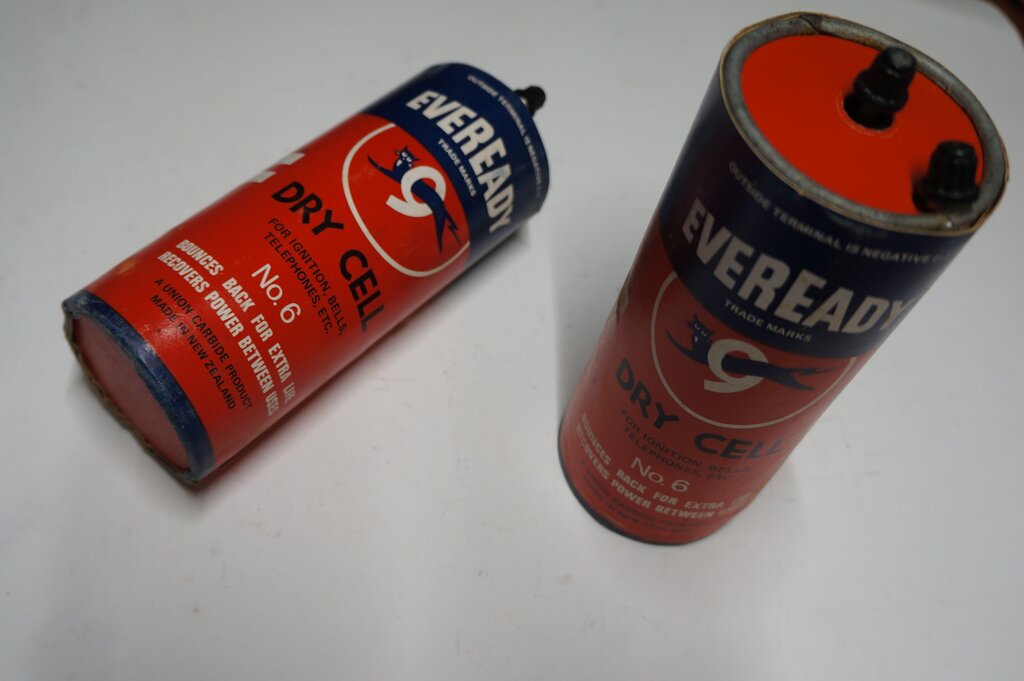
Throughout the history of magneto telephones, the No. 6 dry cell
was the most common power source.
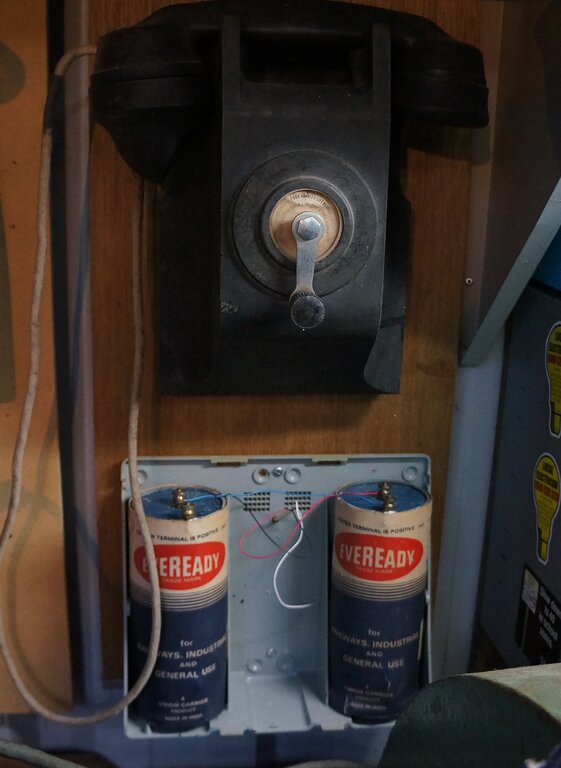
Battery box open showing cells. This battery box allows for a third
cell where 4.5V is required. These cells (made in the famous Bhopal Union
Carbide factory) are old and discharged, but can still provide enough transmitter
current.
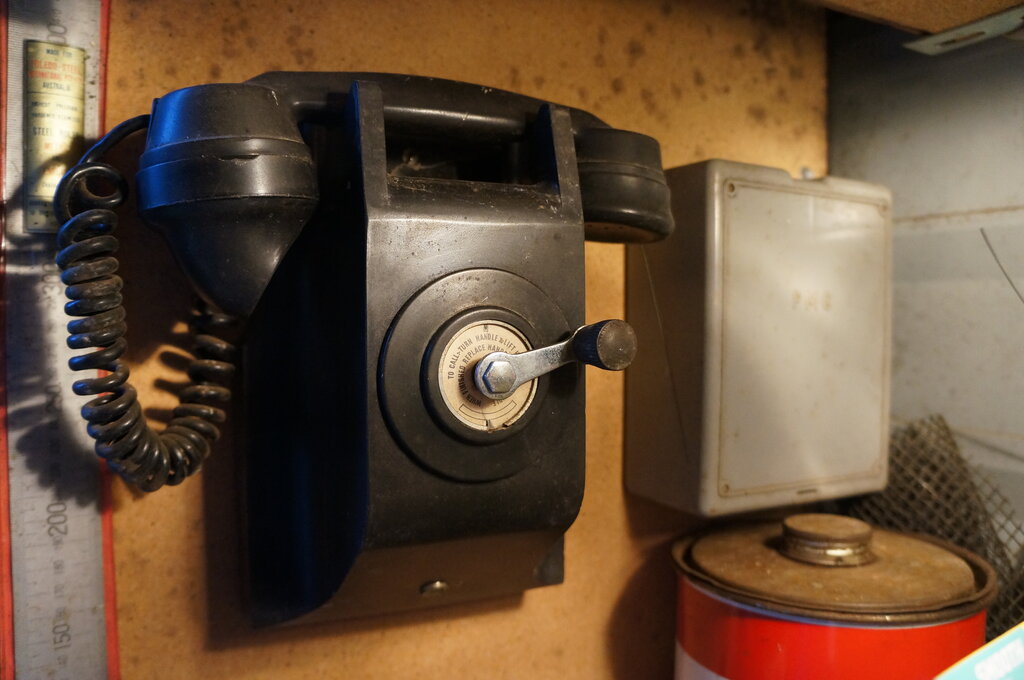
Battery box to the right of the 300 MWK.
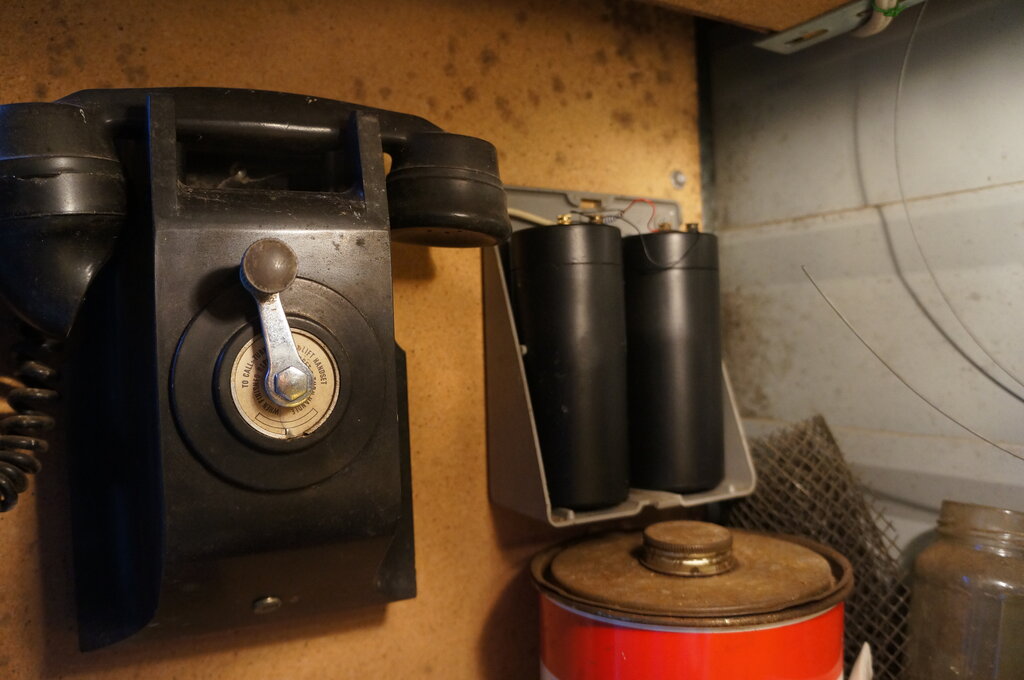
These cells are plastic cased and have been stuffed with parallel
connected alkaline C cells.
No. 6 cells went out of production in Australia
in the 1970's, so the cells were then imported by the PMG / Telecom, from
New Zealand, where they were still produced. The subject of No. 6 dry cells
is an article in itself. Suffice to say, they are harder to get than they
once were. There was an alkaline version called the EN6 (which internally
consisted of two size F cells in parallel) but this is no longer made.
The original carbon zinc types are still available, and are commonly used
for glow plugs on radio controlled models. The black cased cells in the
photo above came from a hobby store in Sydney, and were sold for that purpose.
When they eventually failed, I opened them up and was surprised to find
multiple AA cells connected in parallel. The bottom two thirds of the case
was filled with concrete! I have since installed three paralleled C cells
in the casings. An authentic No. 6 carbon zinc cell has a capacity of about
30Ah.
There have been reproduction No. 6 cells
made available on eBay, which take two user replaceable parallel D cells.
Besides telephones, No. 6 cells were used in a multitude of vintage electrical
and radio applications.
A replacement for the No. 6, which was
being offered in Australia after the demise of local production, was the
No. 735 battery. This looks the same as a 6V lantern battery and also uses
four F cells, except the cells are in parallel to produce 1.5V, and screw
terminals are fitted. My experience with the 735 was that it had a poor
shelf life compared to the No. 6, which is probably why Telecom kept importing
No. 6 cells from NZ. Also, the amp hour capacity is slightly less at 20Ah.
No.6 cells are still available from various
Chinese manufacturers. If searching for them, also look up "R40 cell",
since R40 is a common equivalent. Also search for "glow plug battery 1.5V".
Some are the genuine article, but others as I've mentioned contain AA cells
inside.
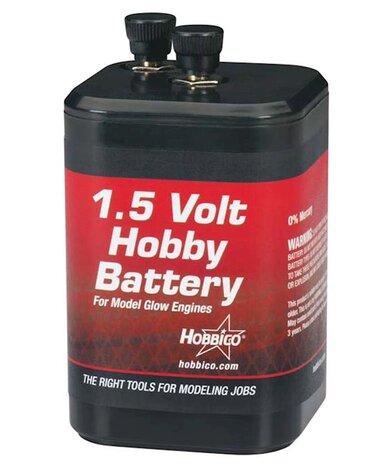
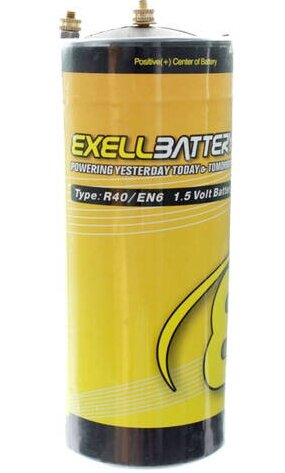
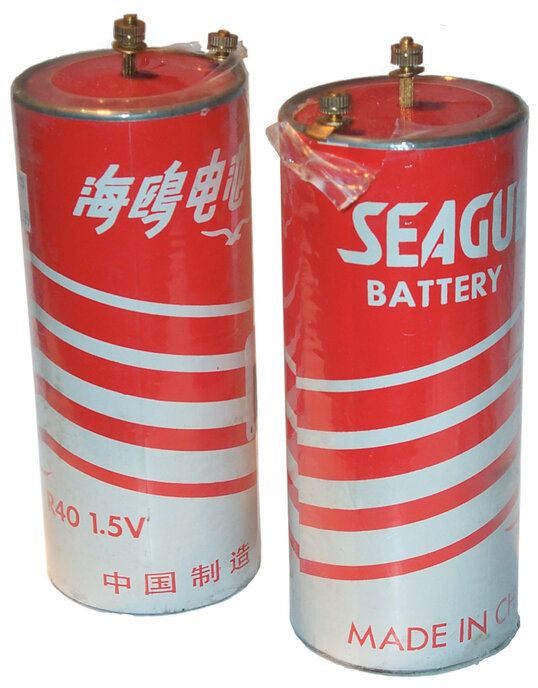
A modern version of the 735. The R40/EN6 is physically the same
as a No. 6. This version can be stuffed with C cells. The Seagull appears
to be the genuine thing.
If originality is not important, the easiest and cheapest option is to simply use a pair of D cells for your magneto phones. Since the transmitter current is very low, at around 25mA, these will last their shelf life. Be wary of alkaline cells, since the modern version of these tend to be prone to leakage. Apparently, this has been caused because mercury is no longer used in their manufacture. If using alkaline cells, mount them away from your antique phones, or in a suitably sealed container, so that if/when leakage occurs no harm is done. On that note, my current preference is for carbon zinc cells.
Connections.
The series 300 and 400 magneto phones
originally used a terminal block for the line connection as standard. Portable
services had a four pin bakelite plug. By the 1970's, the six pin 603 plug
was fitted when the phones were reconditioned.
Terminal Block:
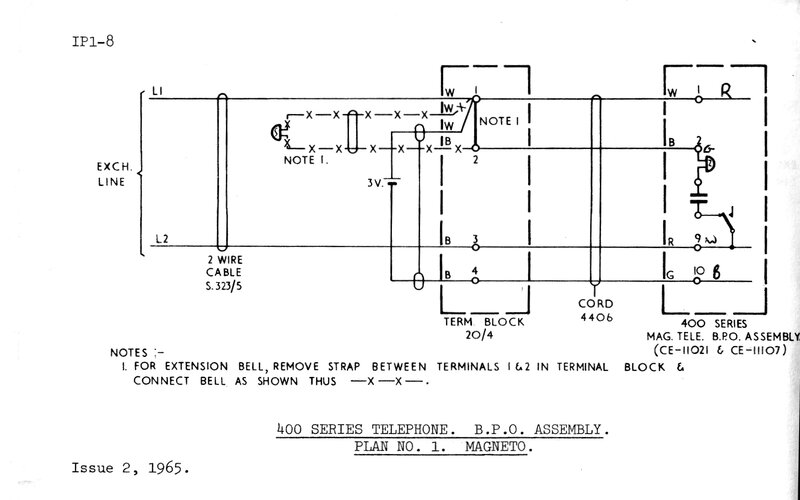
For the 334 MT, see diagram previously shown.
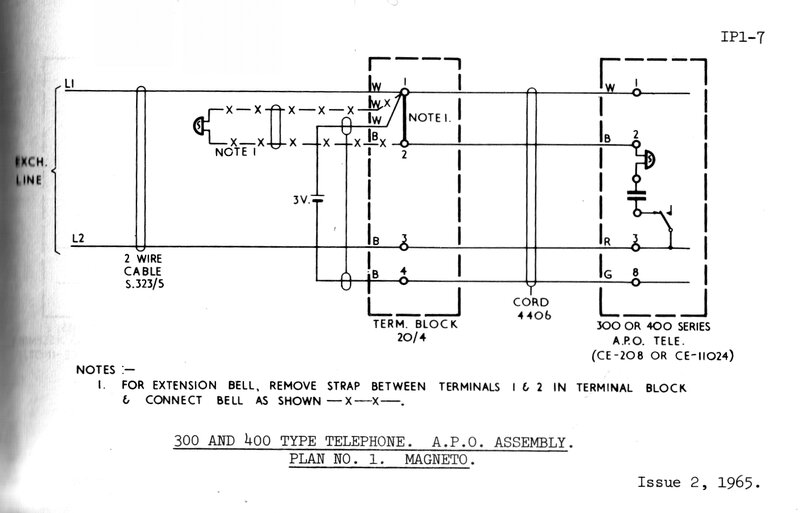
Four Pin Plug and Socket:
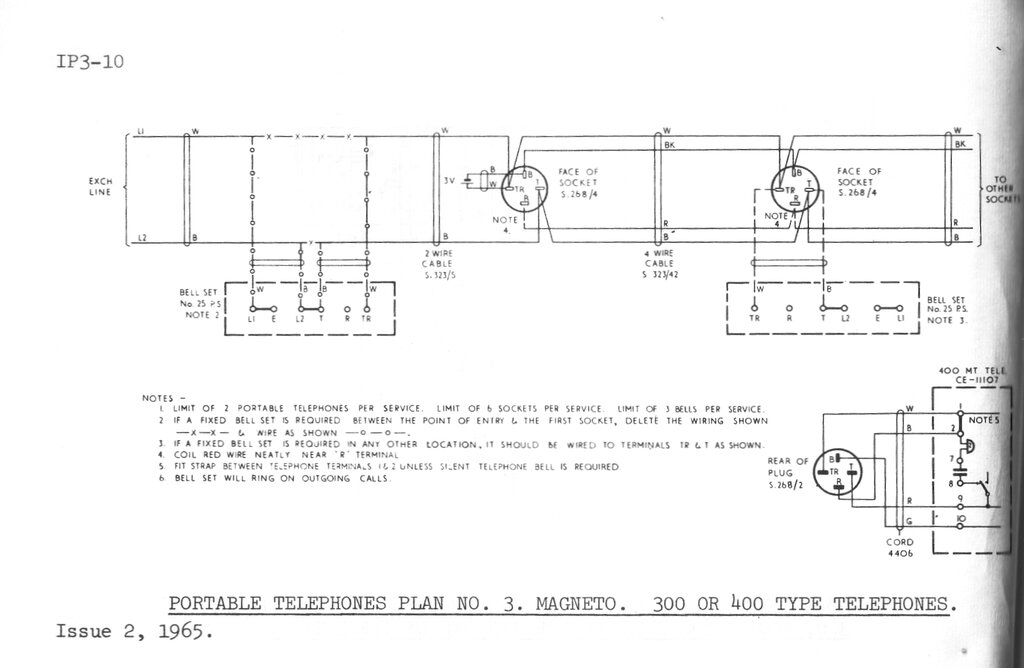
Since plugs and sockets were initially
used only on portable services, the above diagram shows two sockets with
provision for more. Obviously, only one socket actually needs to be installed
if there's only one phone which remains in a fixed location.
603 Plug & 610 Socket for the 334 MT:
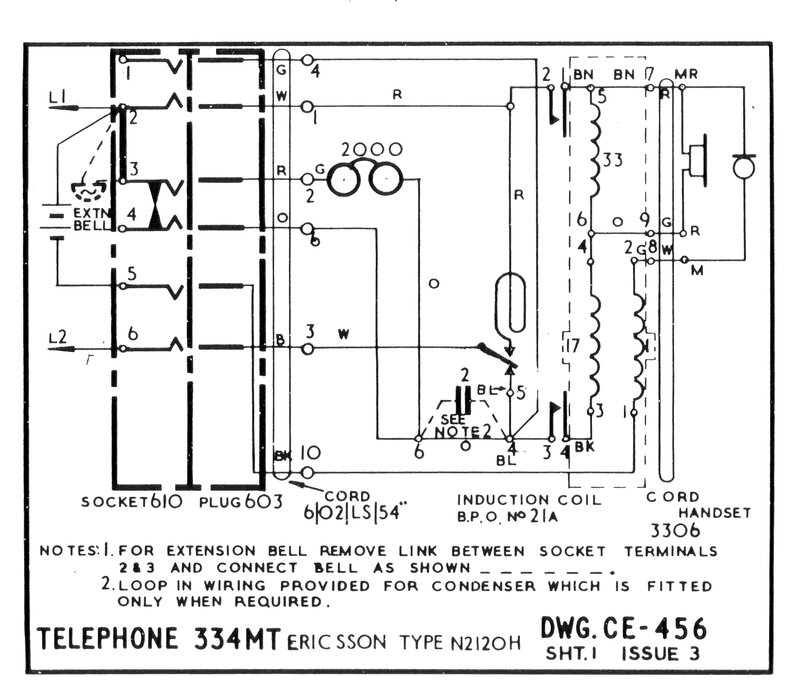
This particular 334MT appears is unusual in that the ASTIC does
not have the balancing components shown. The drawing is much later than
the original instruments (given the plug and socket), and it's possible
a mistake has been made in redrawing it.
603 Plug & 610 Socket for the
APO 400 Series:
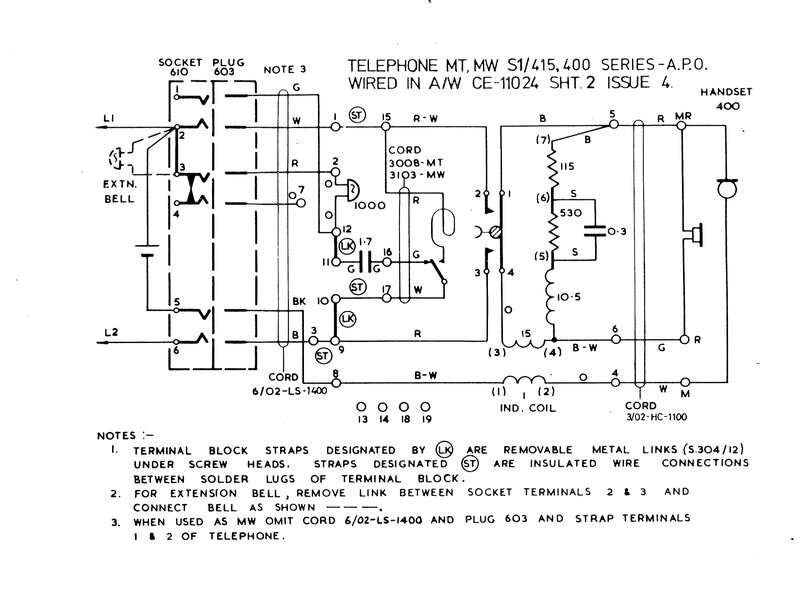
Connecting two or more phones as
an intercom.
L1 and L2 are the normal exchange line
connections. However, for intercom use, the other phone(s) substitute for
the exchange. The magneto is designed to not only drop the indicator shutter
in the exchange, but to also provide the right current for the bells used.
That is to say, the bells and magnetos are designed for each other.
The method is to simply connect all the
L1's together, and then the L2's. When the magneto on any phone is turned,
the bells in all the other phones will ring. A two conductor cable is required,
but it is also possible to use a single conductor with earth return.
As mentioned before, a 3V battery has
to be provided at each phone. Note that the battery positive connects to
L1, although in theory the circuit is not polarity conscious.
Assuming the use of normal two pair (four
conductor) telephone cable, it's possible to use one battery for all phones
by means of a third conductor. How to do this is shown in the parallel
plan previously shown. However, over long distances the transmitting efficiency
of the furthest phone will decrease, because of the line resistance in
series with the transmitter.
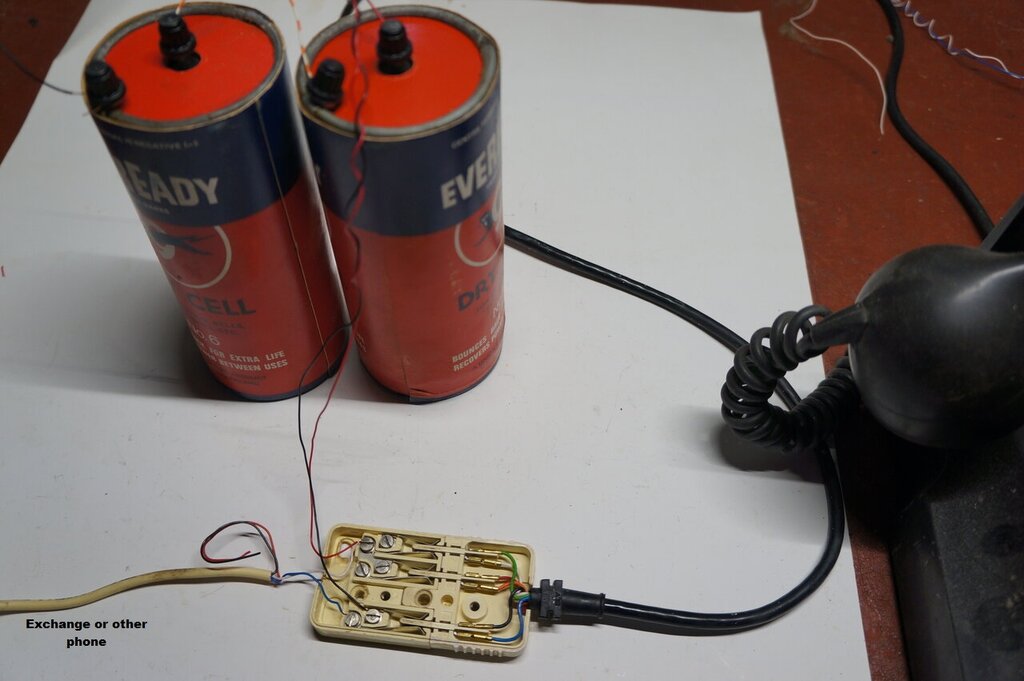
Connecting a magneto phone to an exchange line or other phones.
Note the link between pins 2 and 3 in the socket.
Using a Magneto Telephone on an Automatic
or CB line.
If you have a telephone service through
an internet provider, or still have a proper exchange line, a magneto phone
can be made to function as a central battery phone, and take incoming calls.
Except for the 333MT, the 300/334 and 400 series magneto phones contain
bell isolating capacitors, so that the line is not looped with the handset
on hook. When taken off hook, the line is looped in the normal way and
speech can be heard. A source of power for the transmitter is still required,
and once the usual 3V battery is provided, outgoing speech is then possible.
If by chance, you've got a connection to a CB exchange, outgoing calls
are of course possible simply by lifting the handset in the normal way.
So, you could for example, use a magneto phone with a CB phone by using
this two
line CB exchange.
To prevent any damage to the exchange or ATA, the magneto connections are altered. Using the diagram of the APO 400 as a guide, swap the magneto connections at terminals 16 and 17. Now, when the magneto is turned, its current will go into the bell instead of the line.
A trick is to use the line current to dispense
with the battery. Effectively, the transmitter circuit is connected in
series with the line, so when off hook, line current flows through the
transmitter first, and then into the rest of the phone.
To try this, connect the line to the L2
and battery negative connections (i.e. pins 2/3 and 5 of the 610 socket).
It will be seen that the line current flows through the induction coil
primary and transmitter, and then to the L1 connection.
However, because the L1 connection is now
going through the gravity switch before it gets to the bell, the bell won't
ring with the handset on hook. To fix this, the bell connection at terminal
2 (pin 3 of the 610 socket) is connected directly to the L1 connection
(now pin 5 of the 610 socket). The link between pins 2 and 3 in the socket
is removed.
Using the line current to substitute for
the battery may be questionable in terms of impedance matching, etc., but
experimentally it works.
Note: Magneto telephones
were not designed to be used with DC on the line. If connected to an automatic
or CB line, it will be seen by looking at the circuit, that the entire
line current flows through the receiver.
This is undesirable for several reasons.
Firstly, depending on the polarity of the current through the receiver,
the permanent magnets may be weakened over time. With DC through the windings,
the diaphragm will be biassed which restricts movement in one direction.
And, the fine wire of the windings might not be able to handle the current.
Aside from all that, the anti side tone function will not work properly
in this configuration.
However, in practice, the telephone will function; just not optimally. Experience shows that the receivers will handle normal line currents, and that demagetisation is generally not a problem, given the amount of time the telephone is actually used. There are plenty of cheaply made reproduction phones (notably from India), where the transmitter is simply wired in series with the receiver and connected across the line. The earliest CB telephones were also of this format.
